INVITED REVIEW
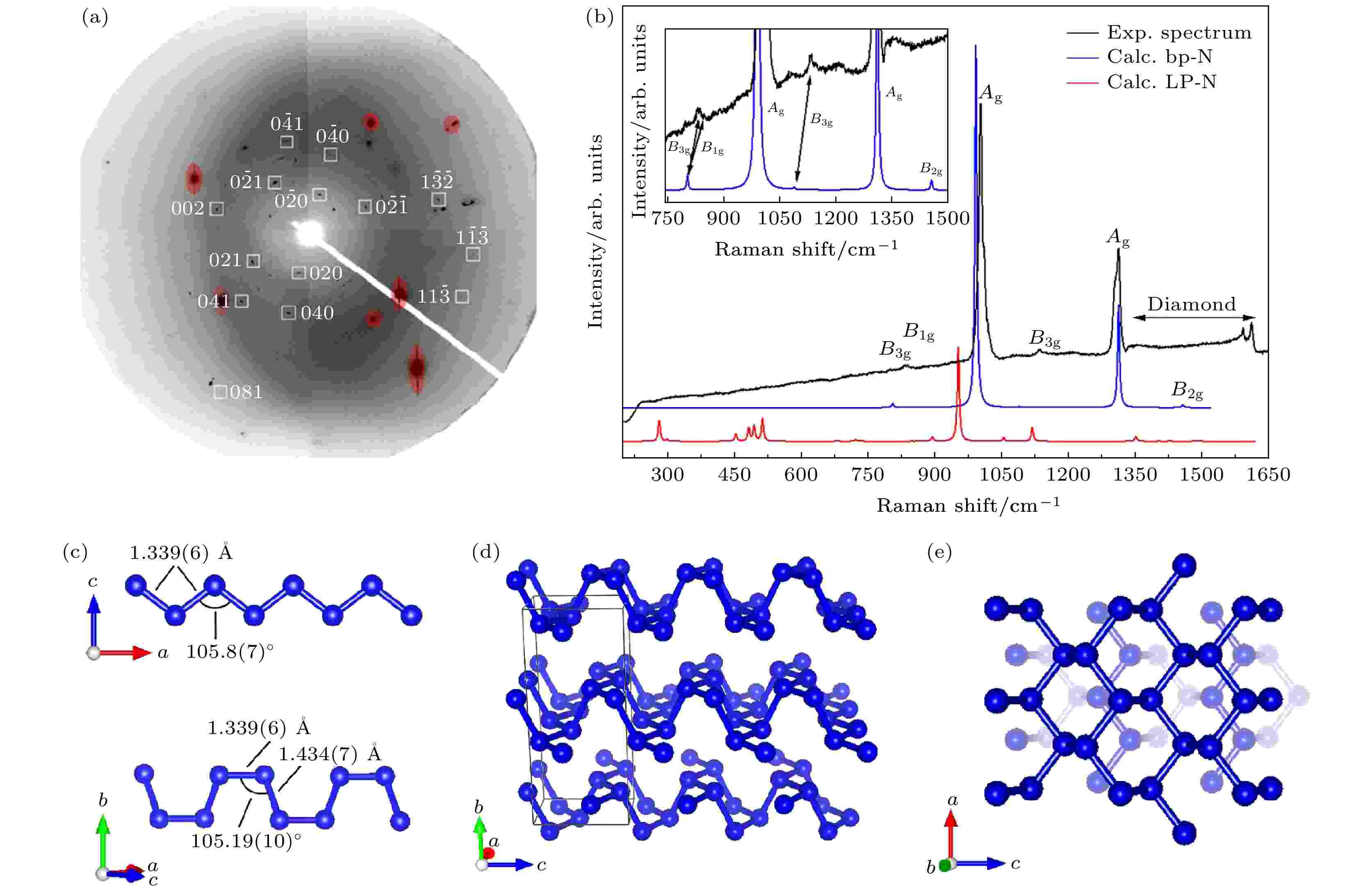
INVITED REVIEW
2021, 70 (14): 148101.
doi:10.7498/aps.70.20210638
Abstract +
Graphene, as the representative of two-dimensional materials, has varous novel physical properties and potential applications. The intrinsic zero band gap of graphene limits its application in semiconductor devices, and thus the search for new semiconducting alternative materials has become a current research hotspot. Phosphorene is the monolayer of black phosphorus and has a puckered honeycomb structure. Its advanced properties, such as adjustable direct band gap, high carrier mobility and in-plane anisotropy and so on, have recently aroused great research interest, thus opening up the research field of puckered honeycomb monolayers in group V elements. In this article, we first focus on the structure, synthesis and physical properties of five single-element two-dimensional materials (nitrogen, phosphorus, arsenic, antimony and bismuth) each with puckered honeycomb structure. Second, some binary two-dimensional materials with puckered honeycomb structure are discussed, including IV-VI and V-V compounds. These materials have their own unique crystal symmetry, and the properties can be controlled by changing their structures and dimensions. Finally, we also make a summary on some current challenges that need to be solved, and the possible future applications of these two-dimensional materials are also presented.
SPECIAL TOPIC—Machine learning and physics
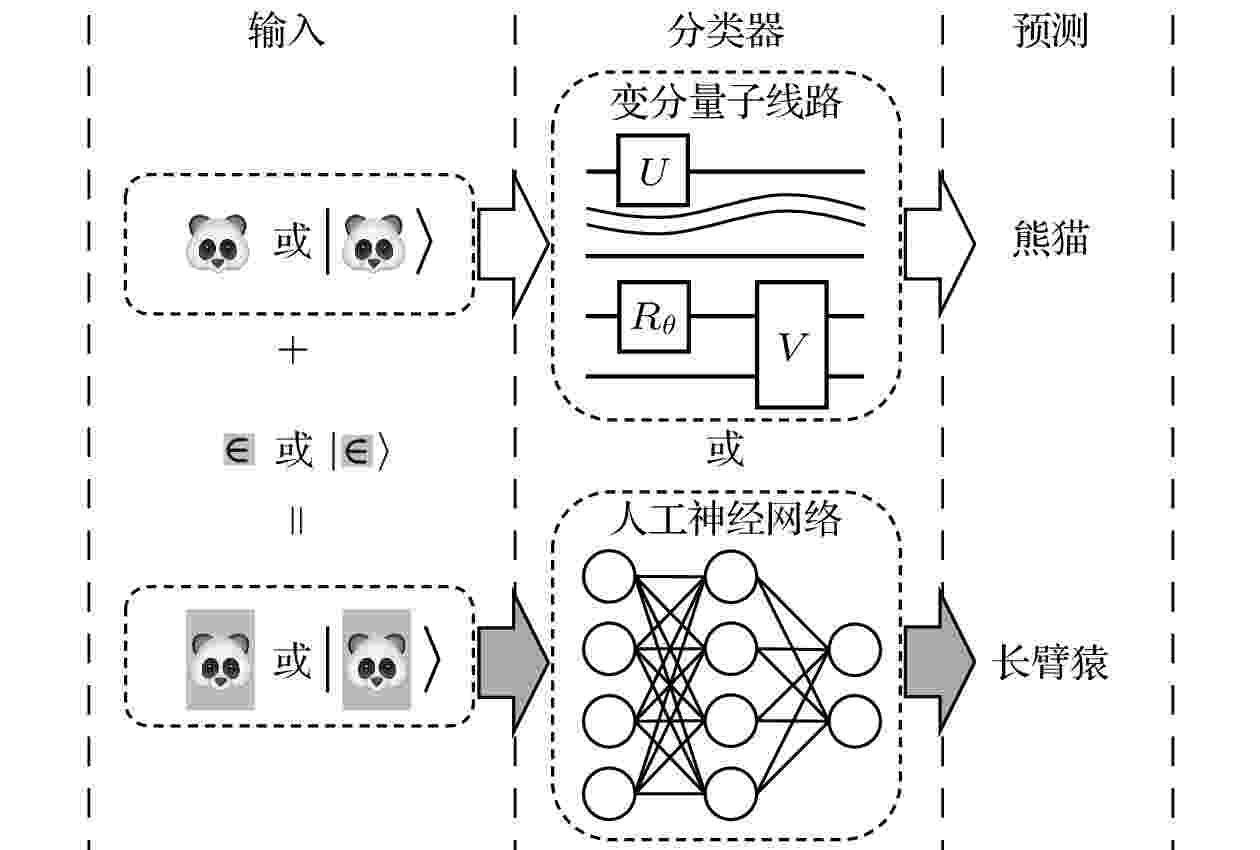
2021, 70 (14): 140302.
doi:10.7498/aps.70.20210789
Abstract +
Quantum artificial intelligence exploits the interplay between artificial intelligence and quantum physics: on the one hand, a plethora of tools and ideas from artificial intelligence can be adopted to tackle intricate quantum problems; on the other hand, quantum computing could also bring unprecedented opportunities to enhance, speed up, or innovate artificial intelligence. Yet, quantum learning systems, similar to classical ones, may also suffer adversarial attacks: adding a tiny carefully-crafted perturbation to the legitimate input data would cause the systems to make incorrect predictions at a notably high confidence level. In this paper, we introduce the basic concepts and ideas of classical and quantum adversarial learning, as well as some recent advances along this line. First, we introduce the basics of both classical and quantum adversarial learning. Through concrete examples, involving classifications of phases of two-dimensional Ising model and three-dimensional chiral topological insulators, we reveal the vulnerability of classical machine learning phases of matter. In addition, we demonstrate the vulnerability of quantum classifiers with the example of classifying hand-written digit images. We theoretically elucidate the celebrated no free lunch theorem from the classical and quantum perspectives, and discuss the universality properties of adversarial attacks in quantum classifiers. Finally, we discuss the possible defense strategies. The study of adversarial learning in quantum artificial intelligence uncovers notable potential risks for quantum intelligence systems, which would have far-reaching consequences for the future interactions between the two areas.
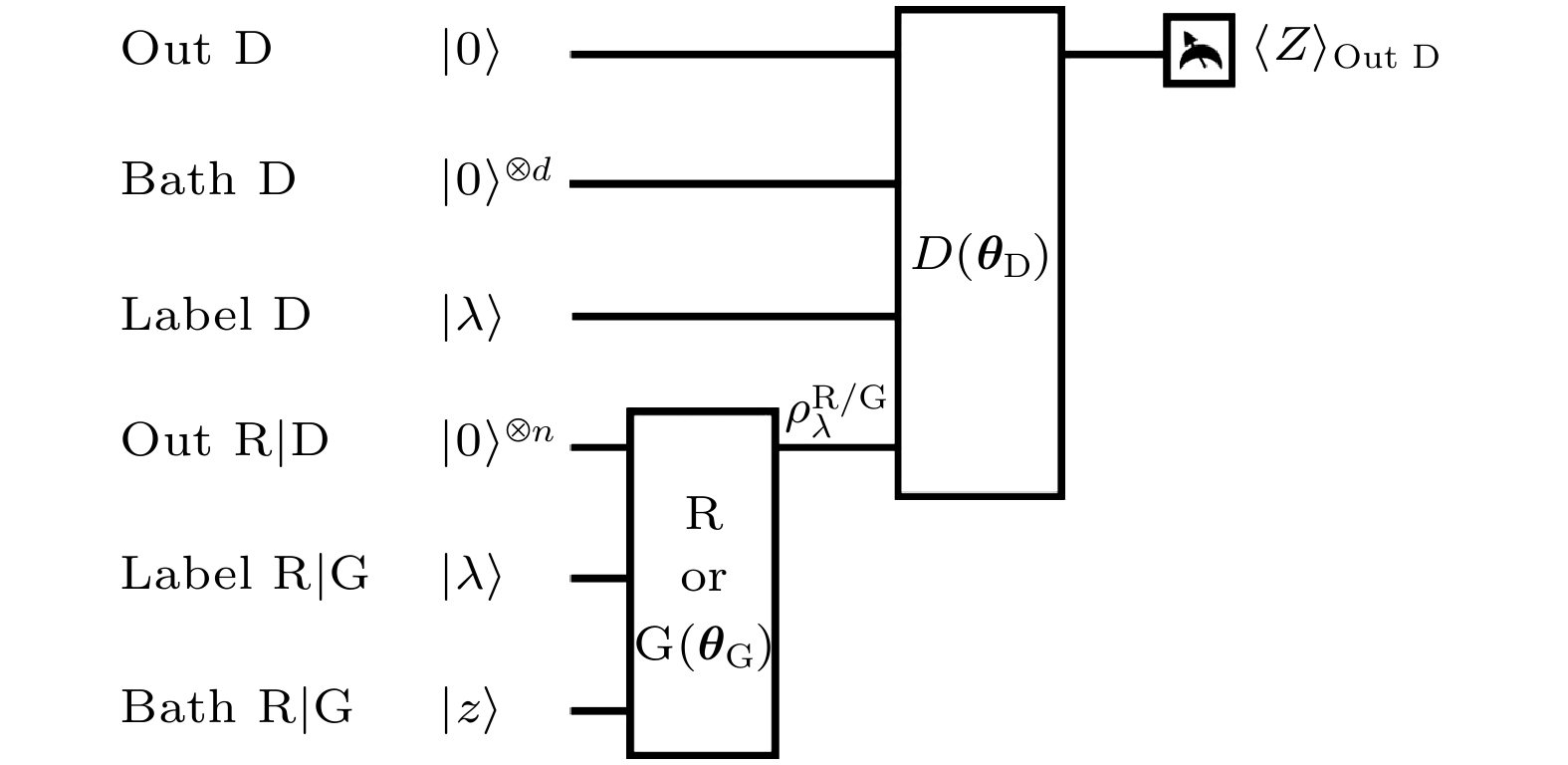
2021, 70 (14): 140304.
doi:10.7498/aps.70.20210930
Abstract +
In recent years, many generation-based machine learning algorithms such as generative adversarial networks, Boltzmann machine, auto-encoder, etc. are widely used in data generation and probability distribution simulation. On the other hand, the combined algorithms of quantum computation and classical machine learning algorithms are proposed in various styles. Especially, there exist many relevant researches about quantum generative models, which are regarded as the branch of quantum machine learning. Quantum generative models are hybrid quantum-classical algorithms, in which parameterized quantum circuits are introduced to obtain the cost function of the task as well as its gradient, and then classical optimization algorithms are used to find the optima. Compared with its classical counterpart, quantum generative models map the data stream to high-dimensional Hilbert space with parameterized quantum circuits. In the mapping space, data features are easier to learn, which can surpass classical generative models in some tasks. Besides, quantum generative models are potential to realize the quantum advantage in noisy intermediate-scale quantum devices.

2021, 70 (14): 140305.
doi:10.7498/aps.70.20210684
Abstract +
Machine learning is widely applied in various areas due to its advantages in pattern recognition, but it is severely restricted by the computing power of classic computers. In recent years, with the rapid development of quantum technology, quantum machine learning has been verified experimentally verified in many quantum systems, and exhibited great advantages over classical algorithms for certain specific problems. In the present review, we mainly introduce two typical spin systems, nuclear magnetic resonance and nitrogen-vacancy centers in diamond, and review some representative experiments in the field of quantum machine learning, which were carried out in recent years.
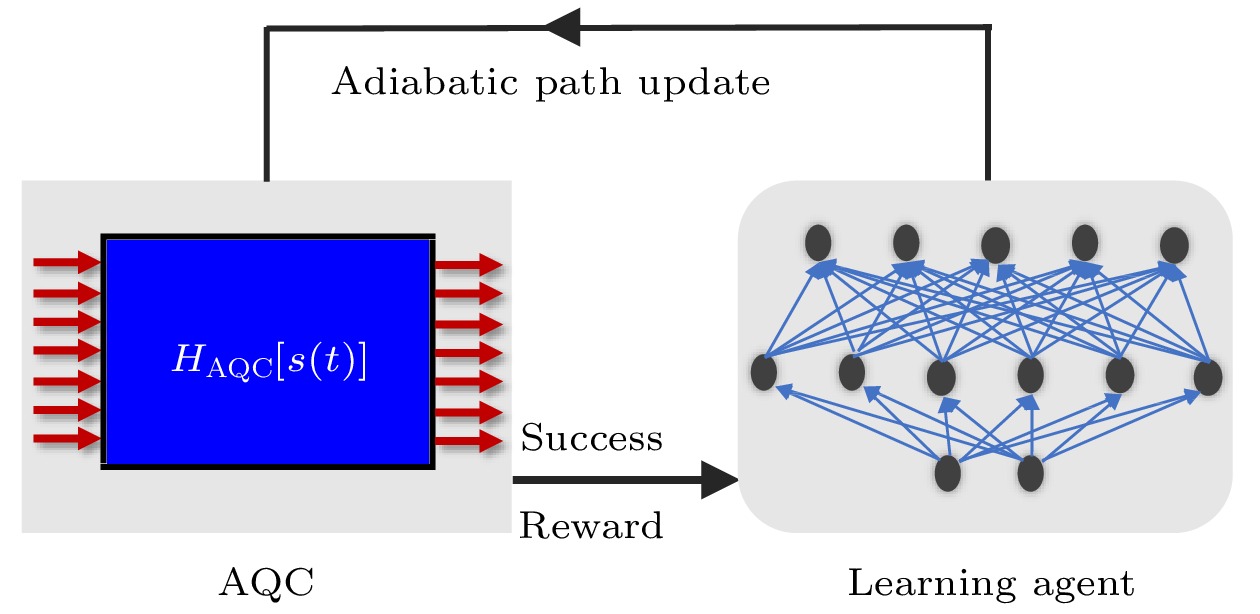
2021, 70 (14): 140306.
doi:10.7498/aps.70.20210831
Abstract +
Quantum computing has made dramatic progress in the last decade. The quantum platforms including superconducting qubits, photonic devices, and atomic ensembles, have all reached a new era, with unprecedented quantum control capability developed. Quantum computation advantage over classical computers has been reported on certain computation tasks. A promising computing protocol of using the computation power in these controllable quantum devices is implemented through quantum adiabatic computing, where quantum algorithm design plays an essential role in fully using the quantum advantage. Here in this paper, we review recent developments in using machine learning approach to design the quantum adiabatic algorithm. Its applications to 3-SAT problems, and also the Grover search problems are discussed.

2021, 70 (14): 140307.
doi:10.7498/aps.70.20210958
Abstract +
The development of traditional classic computers relies on the transistor structure of microchips, which develops in accordance with Moore's Law. In the future, as the distance between transistors approaches to the physical limit of manufacturing process, the development of computation capability of classical computers will encounter a bottleneck. On the other hand, with the development of machine learning, the demand for computation capability of computer is growing rapidly, and the contradiction between computation capability and demand for computers is becoming increasingly prominent. As a new computing model, quantum computing is significantly faster than classical computing for some specific problems, so, sufficient computation capability for machine learning is expected. When using quantum computing to deal with machine learning tasks, the first basic problem is how to represent the classical data effectively in the quantum system. This problem is called the state preparation problem. In this paper, the relevant researches of state preparation are reviewed, various state preparation schemes proposed at present are introduced, the processes of realizing these schemes are described, and the complexities of these schemes are summarized and analyzed. Finally, some prospects of the research work in the direction of state preparation are also presented.
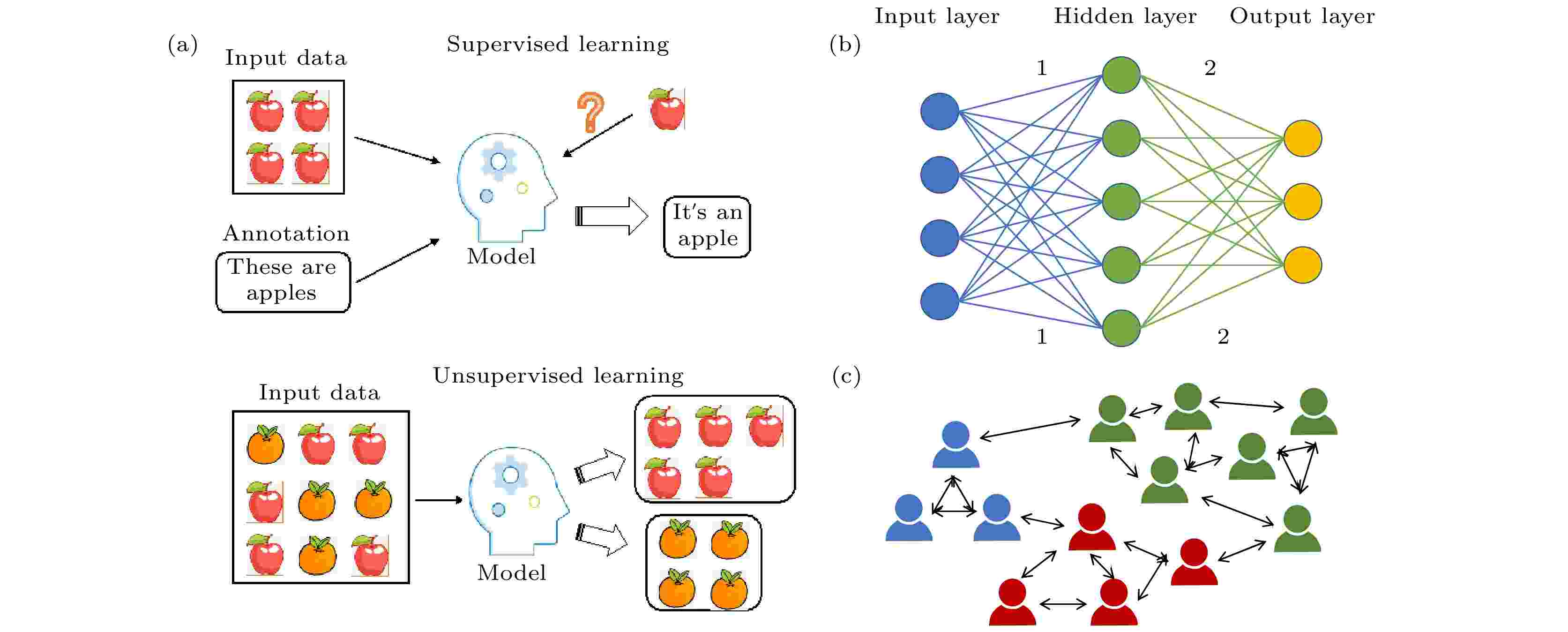
2021, 70 (14): 144204.
doi:10.7498/aps.70.20210879
Abstract +
Recently, the application of physics to machine learning and the interdisciplinary convergence of the two have attracted wide attention. This paper focuses on exploring the internal relationship between physical systems and machine learning, and also on promoting machine learning algorithm and physical implementation. We summarize the researches of machine learning in wave systems and diffusion systems, and introduce some of the latest research results. We first discuss the realization of supervised learning for wave systems, including the wave optics realization of neural networks, the wave realization of quantum search, the recurrent neural networks based on wave systems, and the nonlinear wave computation of neural morphology. Then, we discuss the machine learning algorithms inspired by diffusion systems, such as the classification algorithm based on diffusion dynamics, data mining and information filtering based on thermal diffusion, searching for optimization based on population diffusion, etc. The physical mechanism of diffusion system can inspire the construction of efficient machine learning algorithms for the classification and optimization of complex systems and physics research, which may create a new vision for the development of physics inspired algorithms and hardware implementation, and even the integration of software and hardware.
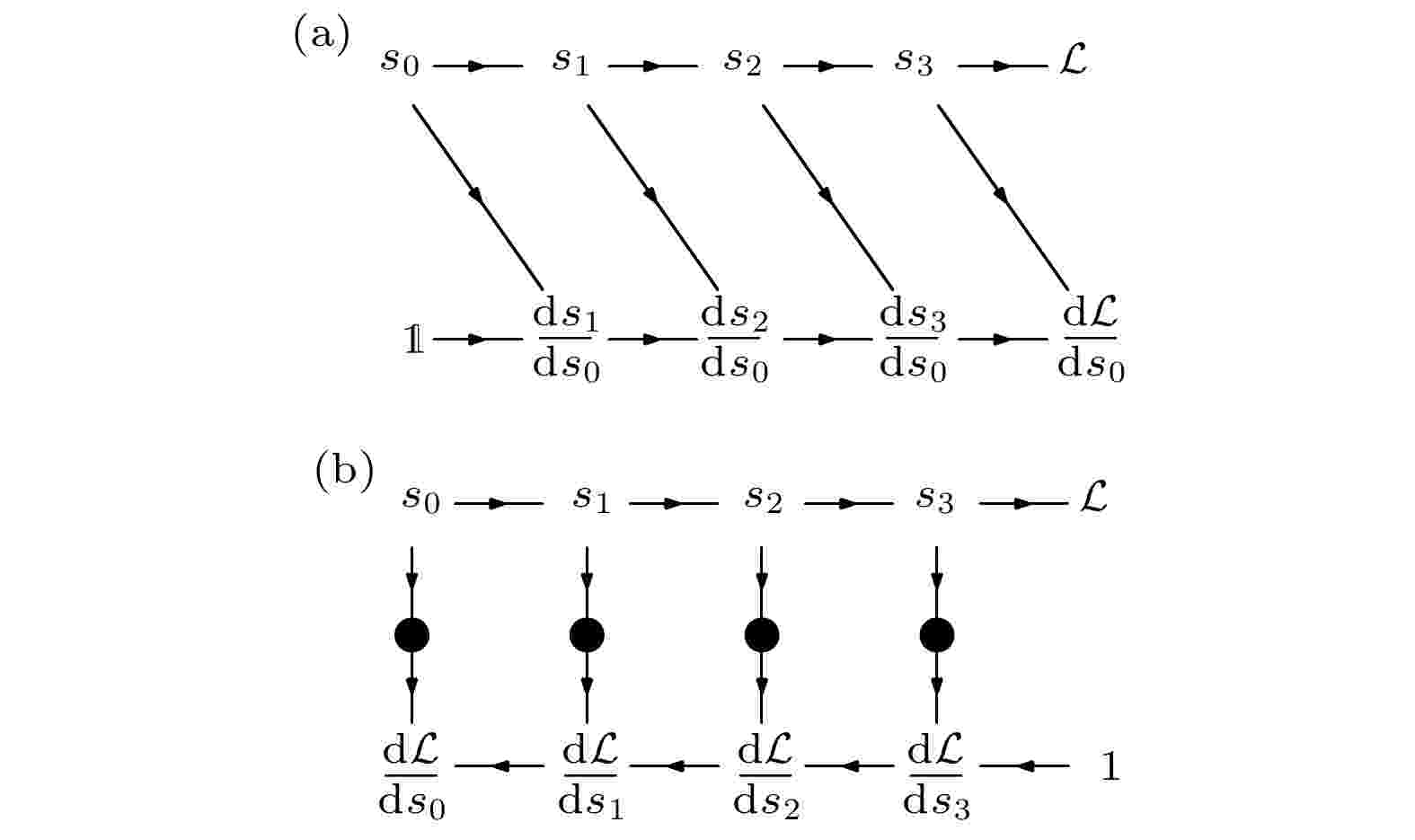
2021, 70 (14): 149402.
doi:10.7498/aps.70.20210813
Abstract +
Automatic differentiation is a technology to differentiate a computer program automatically. It is known to many people for its use in machine learning in recent decades. Nowadays, researchers are becoming increasingly aware of its importance in scientific computing, especially in the physics simulation. Differentiating physics simulation can help us solve many important issues in chaos theory, electromagnetism, seismic and oceanographic. Meanwhile, it is also challenging because these applications often require a lot of computing time and space. This paper will review several automatic differentiation strategies for physics simulation, and compare their pros and cons. These methods include adjoint state methods, forward mode automatic differentiation, reverse mode automatic differentiation, and reversible programming automatic differentiation.
REVIEW
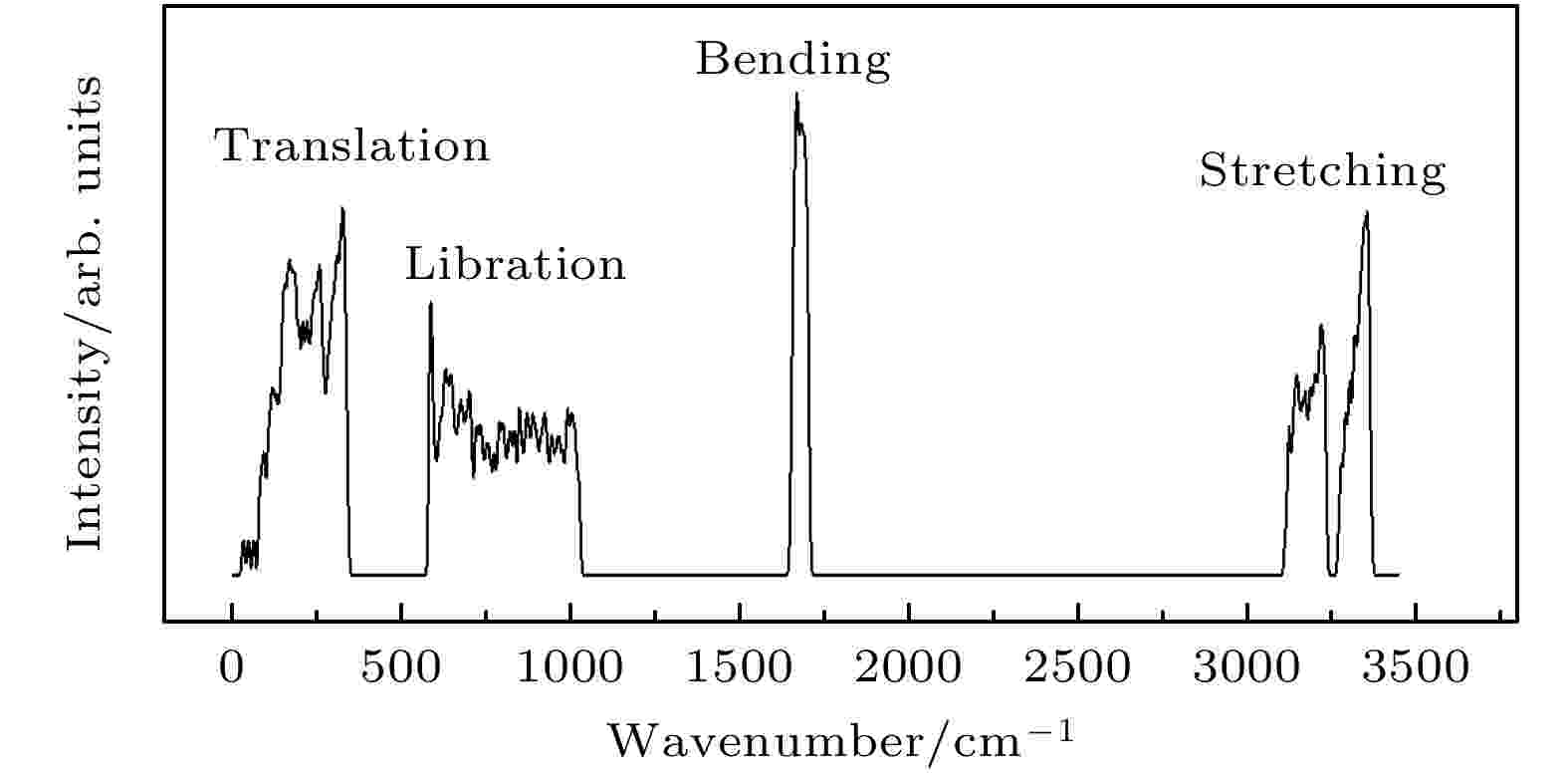
2021, 70 (14): 146301.
doi:10.7498/aps.70.20210013
Abstract +
Despite its simple molecular structure, water is still a mystery to scientists. For the atomic and molecular vibrational modes of ice, as is well known, there are two kinds of vibrations: intra-molecular O—H stretching vibration and H—O—H bending vibration within the molecules and three kinds of molecular spatial rotations. However, thirty years ago, a high flux inelastic neutron scattering experiment showed that there are two distinct characteristic peaks in the far-infrared molecular translational vibration region of many ice phases. The origins of these peaks have not been determined till now. In this work, based on the CASTEP code, a first-principles density functional theory plane wave programme, the vibrational spectra as well as the vibrational normal modes of a series of ice phases are investigated. Two kinds of intrinsic hydrogen bond vibrational modes are first found in hydrogen-ordered ice Ic. Then it is found to be a general rule among ice family. Based on the ideal model, we prove that the two vibrational modes can be classified as four-bond vibration and two-bond vibration. There are many coupling modes in-between due to tetrahedral structure deformation under high pressure. Besides, there are also some optical vibrational modes with lower energy in the translational region, such as cluster vibrations and inter-plane vibrations. In Ice VII/VIII and XV/VI, each of which consists of two sublattices, there exist non-hydrogen bond vibrations. These molecular translational vibrations can explain all the far-infrared vibrational spectrum of ice phase, which makes up the last piece of the jigsaw puzzle for the molecular vibration theory of ice. The two vibrational modes do not exist in liquid water due to the collapse of the rigid tetrahedral structure. Thus, a window remains for ice resonance absorption with minimum energy loss in water. This theory is expected to be applicable to industrial deicing, food thawing, gas hydrate mining, and biomolecule frozen molding, etc.
2021, 70 (14): 148701.
doi:10.7498/aps.70.20201794
Abstract +
Boron neutron capture therapy (BNCT) is a dual tumor radiotherapy method combining boron-10 containing drugs and heavy ion therapy, which can kill cancer cells with almost no damage to normal cells, and achieve precise cell-scale treatment. However, the BNCT does not really enter into clinical application stage though it has been developed for nearly 70 years. The methods of measuring the concentration distribution of boron-10 containing drugs in vivo cannot meet the clinical needs, which is one of the core problems affecting the effect and safety of clinical application of BNCT. This article reviews the current methods of measuring the concentration distribution of boron-10 drugs, including the invasive estimation methods that have been used in clinical practice, the researching single photon emission tomography (SPECT) method, positron emission tomography (PET) method, nuclear magnetic resonance (NMR) method, etc., and analyzes the advantages and limitations of current methods. Based on the characteristics of the low gyromagnetic ratio of the boron-10 element and the extremely short magnetic resonance transverse relaxation time, the research ideas of ultra-short echo time magnetic resonance boron-10 quantitative imaging are proposed. The feasibility of quantitative measurement of boron-10 distribution in vivo based on ultrashort echo time magnetic resonance imaging is analyzed theoretically.
GENERAL
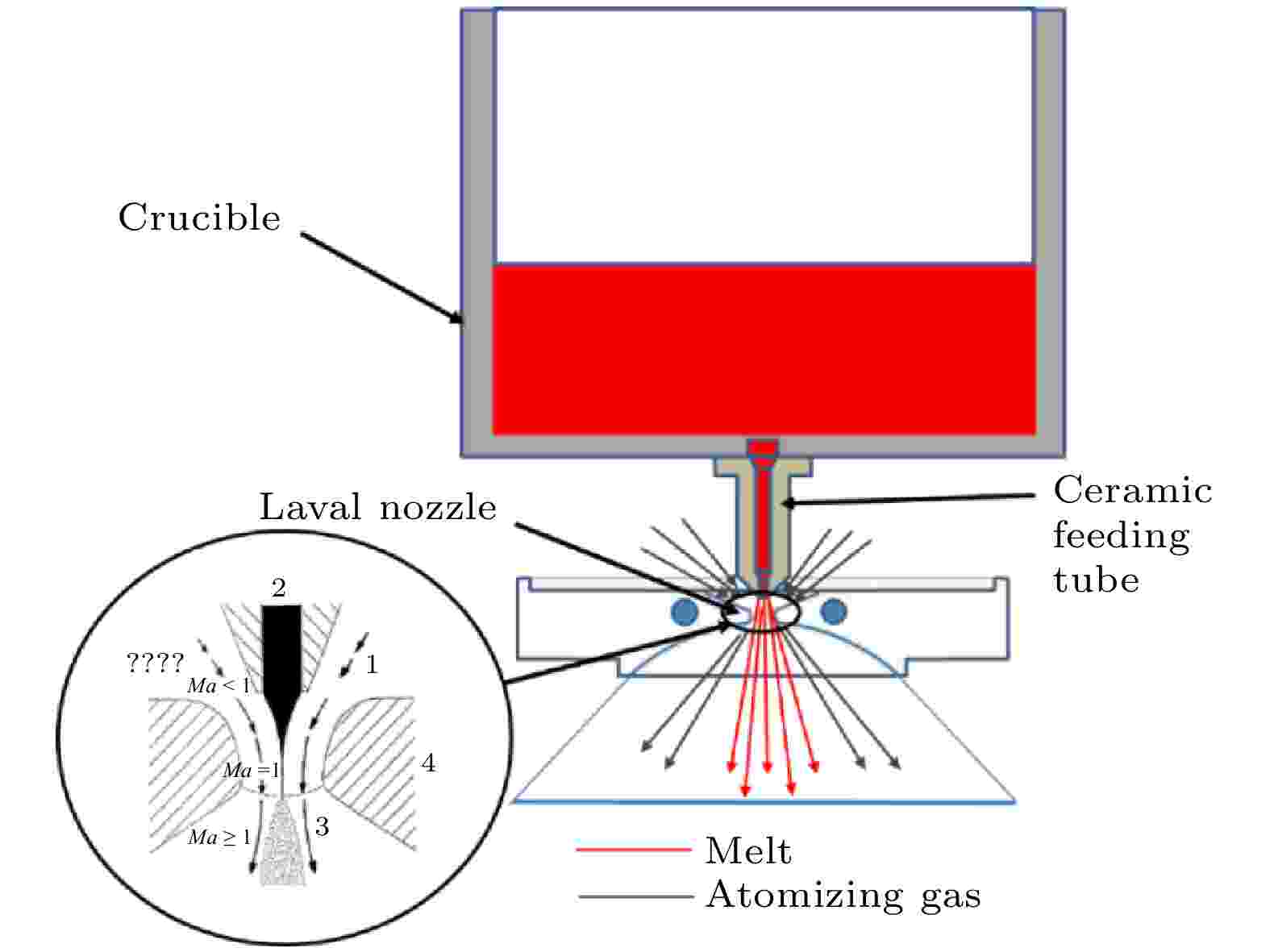
2021, 70 (14): 140201.
doi:10.7498/aps.70.20202071
Abstract +
Metal powders prepared by laminar flow gas atomization have the advantages of small particle size and narrow particle size distribution. At present, the research on laminar flow gas atomization mainly focuses on the influence of process parameters on atomization and powder characteristics, but the atomization mechanism of laminar flow gas atomization is still not clear. In this work, the atomization gas flow, primary and secondary breakup mechanism, and particle morphology of the laminar flow gas atomization process are systematically investigated through numerical simulation and experimental analysis. The characteristics of single-phase atomization gas flow through the De Laval nozzle are studied using the standardk-εturbulence model. The flow field structure shows a “necklace”-like structure with an expansion wave cluster of oblique shock. The primary and secondary atomization mechanism are investigated using the coupled level-set and volume-of-fluid model, which is validated by solidified fragments and powders after the atomization experiment, and results of the numerical simulation also provide some important advices for the application and specific process of laminar gas atomization technology. The studies indicate that the melts at the periphery of the liquid column are mainly peeled off by filaments or ligaments, which exhibits the small dimension and pressurized melt atomization characteristics. The secondary atomization is mainly based on the disintegration of spherical droplets in the mode of Rayleigh-Taylor instability deformation and sheet-thinning breakup. The simulation results also show that increasing the gas pressure and melt superheat can effectively reduce the probability of irregular powders to occur. The AlSi10Mg powders are obtained under a pressure of 2.0 MPa in the experiment on gas atomization, and the properties of the powders are analyzed. The results show that the powders have good sphericity and flowability, and the proportion of hollow powders is very low. In addition, the mean particle size of the AlSi10Mg powders is 54.3 μm, and the yield of fine powders reaches 48.7%, which is greatly improved compared with the traditional gas atomization processes. Moreover, about 90% of the powders have particle sizes in a range of 30–100 μm, which indicates that a narrow particle size distribution can be obtained by the laminar gas atomization technology.
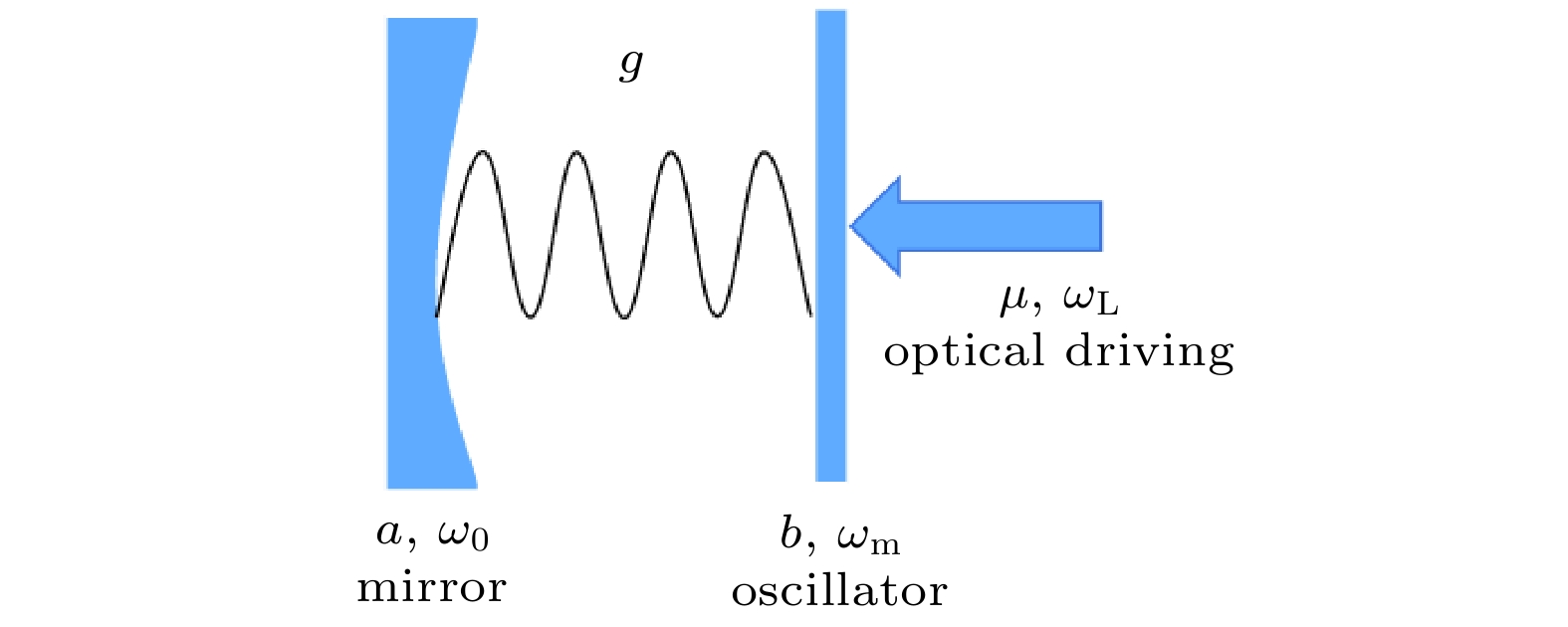
2021, 70 (14): 140301.
doi:10.7498/aps.70.20210178
Abstract +
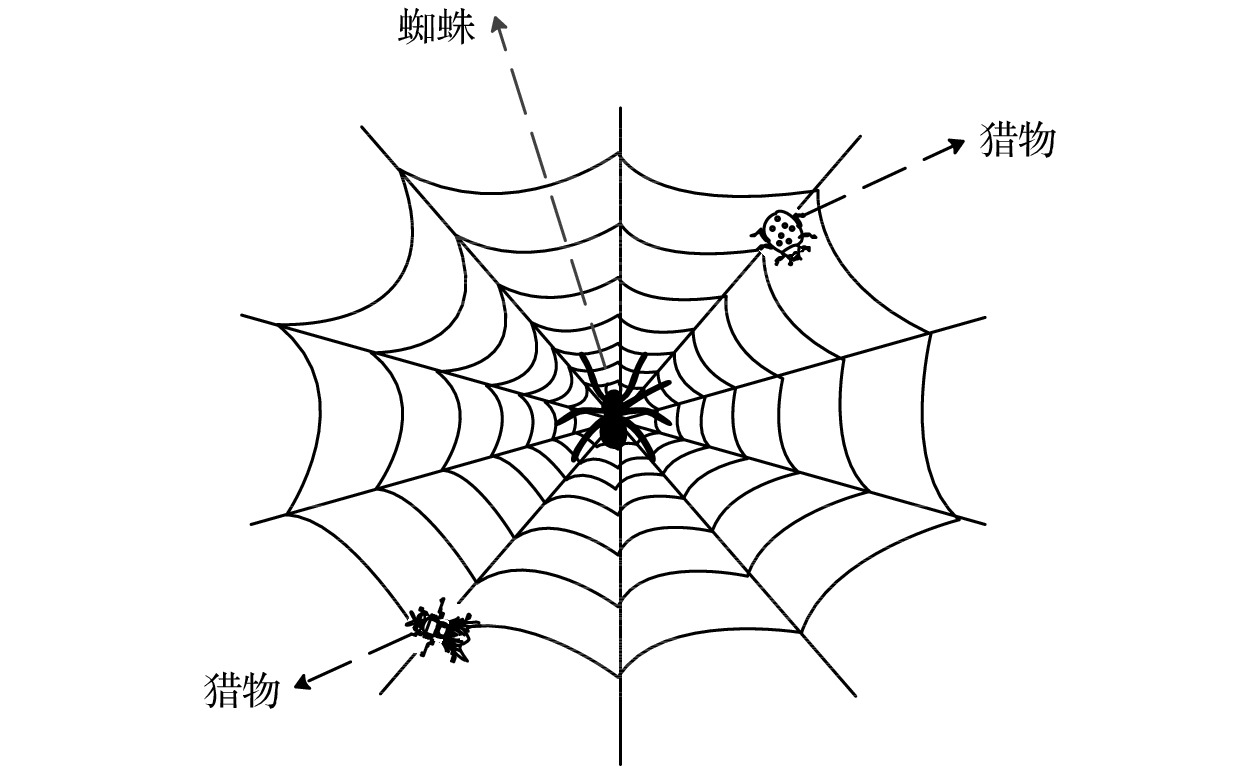
EDITOR'S SUGGESTION
2021, 70 (14): 140303.
doi:10.7498/aps.70.20210556
Abstract +
Quantum satellite communication is a research hotspot and frontier in the field of communication. It has the advantages of ideal information security and wide coverage, which is of great significance in constructing a global quantum satellite wide area network. However, problems such as network reliability, security and routing relay still need to be improved when transmitting information over long distances. In this paper, the spider web is used as a unique natural communication topology to transform the natural spider web into an artificial spider web topology. The quantum information transmission adopts N-order quantum teleportation routing scheme, and the transmission delay is basically unchanged. On this basis, the spider web topology quantum wide area network transmission model is constructed. The bit error rate, throughput rate and security key generation rate of the network model are simulated and analyzed. Taking 9-node ring network and 9-node cobweb for example, the quantitative analysis and qualitative analysis are both conducted in this paper. The results show that the cobweb topology has higher reliability. When the average power spectral density of the noise is given and there is no relay, the bit error rate increases with the transmission distance increasing, so the introduction of relay should be considered. When the transmission distance and noise power spectral density are constant, the bit error rate decreases with the number of relay nodes increasing, so the appropriate routing process should be selected in the spider web topology. With the increase of the probability of transmitting entangled photon pairs, the throughput rate gradually increases. With the increase of transmission delay in the network, the throughput rate Q gradually decreases. However, the transmission delay is basically unchanged in this routing scheme, and the transmission delay of cobweb structure is very small. Therefore, the throughput rate of the topology quantum WAN of cobweb network based on N-order quantum teleportation proposed in this paper will not significantly decrease. When the transmission distance of quantum information increases, the network key generation rate decreases gradually. With the increase of the number of network relay nodes, the key generation rate increases gradually. Thus, it can be seen that using cobweb topology and N-order quantum teleportation routing scheme to construct a quantum satellite WAN has good advantages.
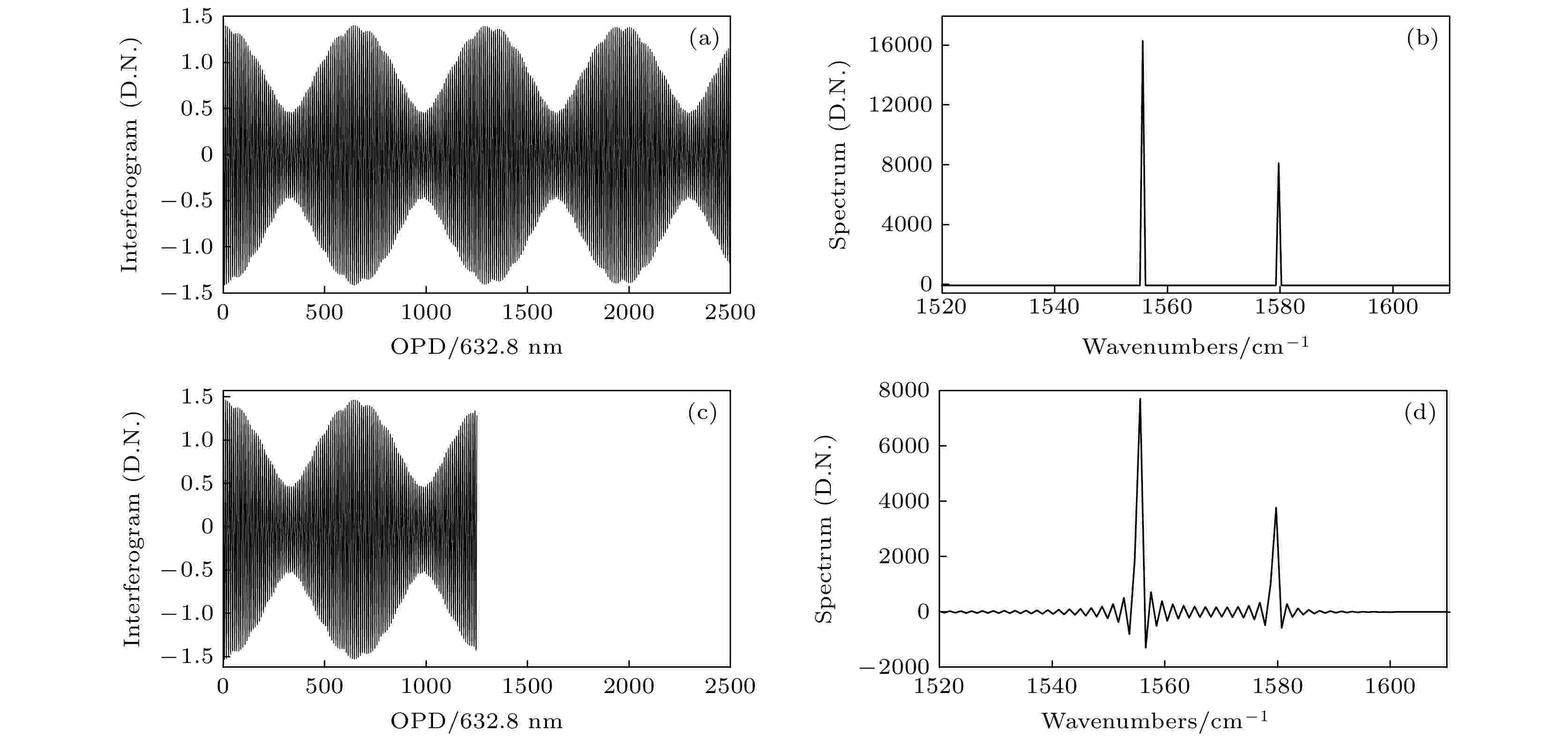
2021, 70 (14): 140701.
doi:10.7498/aps.70.20210302
Abstract +
Interferometric infrared spectral radiometer has high luminous flux and large passing aperture, so the spectral data collected by the instrument are the convolution of the target spectral data and the instrument line shape (ILS). The main factors affecting the ILS include truncation effect, finite field of view effect, off-axis effect, defocus effect and relative position of detector and so on. In this paper the truncation effect, finite field of view effect, off-axis effect and defocus effect on ILS are expounded. These ILS errors all cause the ideal spectrum to drift towards the low wave number and widen. In this paper, the ideal absorption spectrum of water vapor is simulated by the line-by-line integration, through using MATLAB software and combining with the data of water vapor spectrum in HITRAN database, and the quantitative relationship between the error of instrument linear function and spectral distortion is established. According to the simulation results, a factor weight correction algorithm is proposed. It is believed that with this method, the error spectrum caused by ILS has the same optical properties as the ideal spectrum, but the optical path difference is different. Therefore, the coefficient matrixHcan be constructed to establish the quantitative relationship between the error spectrum and the ideal spectrum, and the error spectrum can be corrected by using Landweber iterative algorithm. In this paper, the simulation data of water vapor absorption are used to verify the factor weight correction algorithm, and the spectral drift decreases from 0.51 cm–1to less than 0.01 cm–1. The accuracy of the factor weight correction algorithm is verified by the experimental observation of the standard black body with self-developed interferometric infrared spectral radiometer. The spectral drift of the measured data decreases from 0.226 cm–1to 0.012 cm–1, and the corrected spectral data are more accurate.
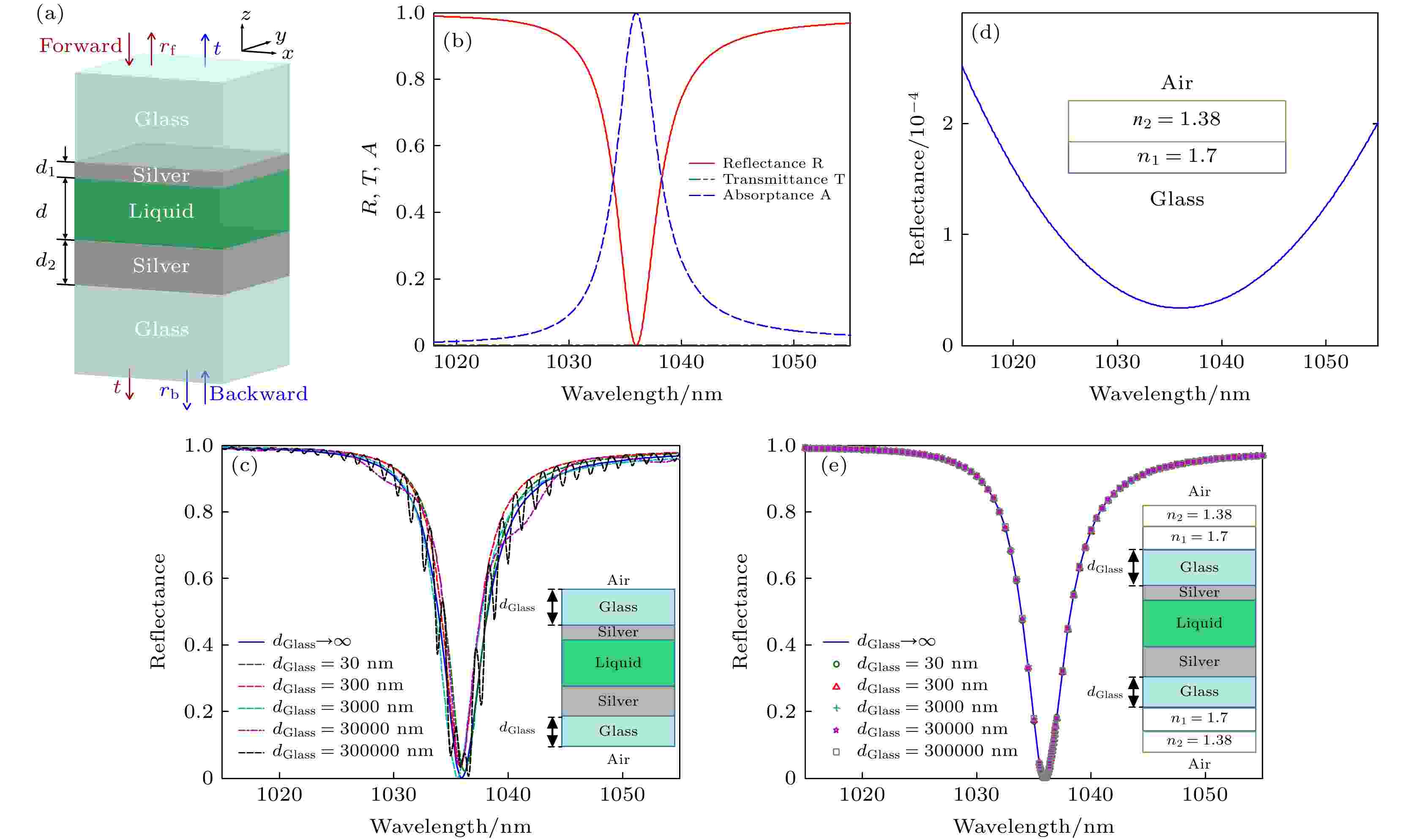
2021, 70 (14): 140702.
doi:10.7498/aps.70.20202058
Abstract +
The metal-dielectric-metal multilayer structure sensor with a transparent top layer and an opaque bottom layer is proposed, which can provide a perfect narrow-band absorption resonance and is suitable for sensing refractive index change of the liquid to be measured in dielectric layer. The Fabry-Perot resonance analytical model that can accurately reproduce response spectrum and theoretically analyze the mechanism of the dielectric layer thickness to tune resonance wavelength and linewidth of response spectrum is constructed. Theoretical analysis shows that the resonance wavelength is directly proportional to the thickness of dielectric layer, and the full width at half maximum is inversely proportional to the thickness of dielectric layer. The analytical expressions for its resonance wavelength, quality factor, full width at half maximum and sensitivity are also given. When used for the refractive index sensing, the quality factor and figure of merit of the proposed multilayer structure based on the 8th order Fabry-Perot resonance are 2162.8 and 1648.1 RIU–1, respectively. However, due to the influence of the minimum resolution of the spectrometer, the conventional method of measuring resonance wavelength shift to achieve refractive index sensing has a high measurement limit. For the sensing of weaker refractive index perturbation, with the help of superposition of exceptional point degenerate state and tuning mechanism of Fabry-Perot resonance, in this paper proposed is a method of tunably sensing the liquid refractive index by measuring the increase of reflection coefficient or splitting of eigenvalue at a specific wavelength. Here, we take for example the metal-dielectric-metal multilayer structure sensor based on the 8th order Fabry-Perot resonance. According to the calculation results of Fabry-Perot model, when the change in refractive index of liquid to be measured is 10–4RIU, the increase of forward reflection coefficient and the splitting of two eigenvalues of the scattering matrix are 0.319 and 1.1279, respectively.

2021, 70 (14): 140703.
doi:10.7498/aps.70.20210185
Abstract +
Noise is one of the main factors affecting the performance index of weak signal detection devices, and the optimal filtering algorithm is an effective method to adaptively extract various useful weak signals from the white noise background. In order to improve the performance of single photon detector (especially the photon number resolution ability), one mainly focuses on the optimization of detector hardware such as the optimization of photosensitive materials and the technology of device fabrication. However, in this paper the performance of microwave kinetic Inductance detector (MKID) in the way of data processing is improved. Considering the fact that the template of light pulse signal in the optimal filtering algorithm is obtained by taking the average, we replace the noise model in the original optimal filtering algorithm with the white noise model and the whitening noise model. Then we process the photon response data that are detected by the MKID in an extremely low temperature environment. The results show that the energy resolution (one of the main performance indexes of single photon detector) of MKID is improved by about 15%, and we achieve an infrared single photon energy resolution of 0.26 eV. In this paper, the application and development trends of superconducting single photon detector are briefed. Then, how the MKID responds to weak coherent optical signal in low temperature environment, and the process of signal conversion, acquisition and output are explained in detail. According to the optimal filtering algorithm, we use different noise models to analyze the results of the signals detected by MKID. After that, we count the optimal amplitude multiple, perform the Gaussian fitting analysis on the statistical graph, and compare the energy resolution with the photon number resolution of the optimal filtering algorithm under different noise models. As a result, we find that under the white noise model, the optimal filtering algorithm is used to obtain the best result for MKID processing, and high energy resolution can be achieved.
ATOMIC AND MOLECULAR PHYSICS
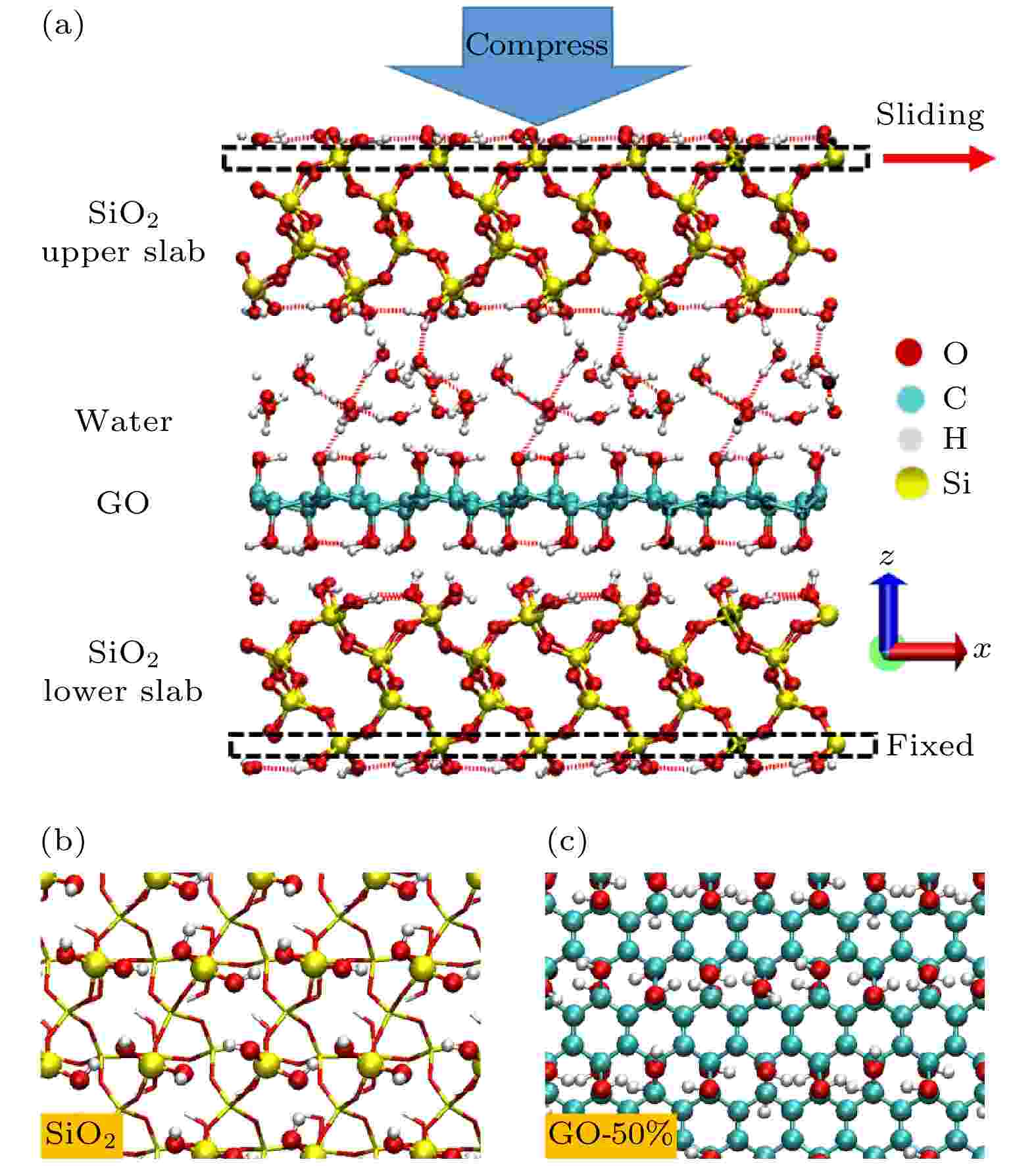
2021, 70 (14): 143101.
doi:10.7498/aps.70.20210088
Abstract +
Theab initiomolecular dynamics method is used to simulate the friction process of the graphene sheet as lubricant added to the silicon-based material interface under the action of compression and shear, and the influence of water molecules and oxidation of graphene surface on the movement behavior of graphene sheet are studied. In a dry environment, the pristine graphene (PG) sheet will slip only when the pressure is high. Owing to the presence of surface functional groups, a strong force is formed between the graphene oxide (GO) sheet and the substrate. The direction of the hydroxyl groups on the surface of the upper slab is consistent as the upper slab moves at a constant speed, resulting in the fact that the force between the GO sheet and the upper slab is greater and the GO sheet slides forward with the upper slab. Owing to the formation of mechanical interlock between the GO sheet and the lower slab surface, the GO sheet no longer slips when the pressure is high. In a humid environment, the interface structure affects the overall distribution and movement state of water molecules. The water molecules between the PG sheet and the upper slab are adsorbed only on the surface of the upper slab and always remain in a “flat” state, and their motion behavior is consistent with the upper slab’s. Comparing with a dry environment, the PG sheet starts to slip only when the pressure is high. Since the hydroxyl orientation angle on the surface of the upper slab is greater than the hydroxyl orientation angle on the surface of the GO sheet, the water molecules gradually change from the "flat" state to the slightly “upright” state as the pressure increases. The change of the orientation of water molecules makes the bonding strength between water molecules and the GO sheet gradually decrease, leading to a relative slip between them. The change in the movement behavior of the graphene sheet causes the shear plane to change. There is a positive correlation between the velocity fluctuation mean square error of the graphene sheet and the friction coefficient as the oxidation rate of graphene sheet increases under different coverages of water molecules, indicating that the motion behavior of the lubricant affects the interface friction characteristics.
ELECTROMAGNETISM, OPTICS, ACOUSTICS, HEAT TRANSFER, CLASSICAL MECHANICS, AND FLUID DYNAMICS
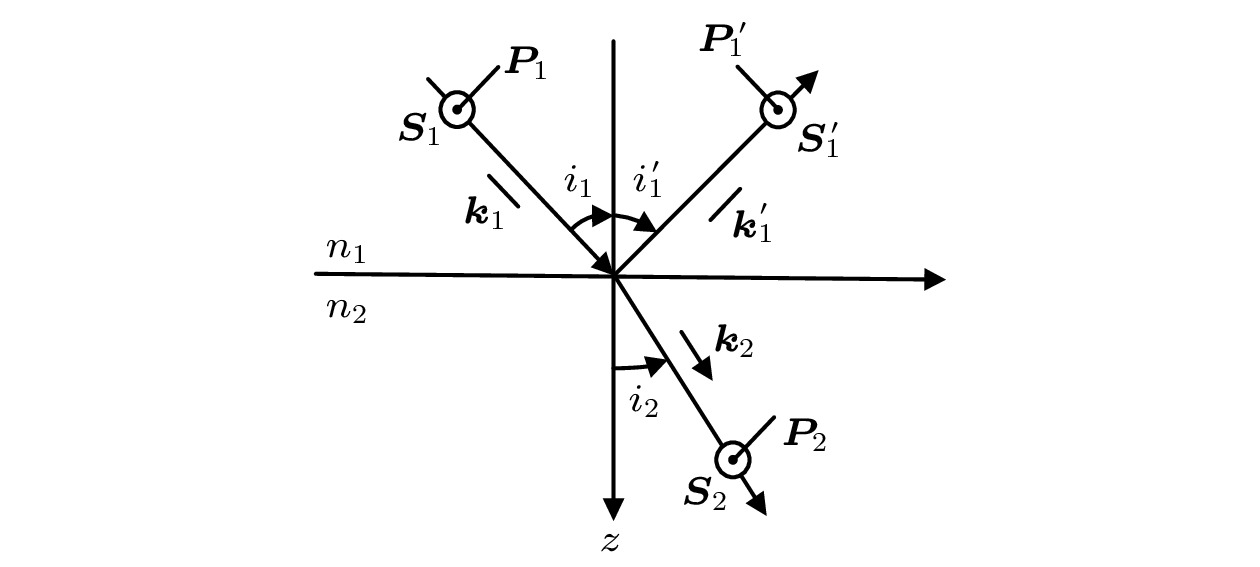
2021, 70 (14): 144201.
doi:10.7498/aps.70.20202152
Abstract +
Underwater optical imaging is an important way to implement the seabed exploration and target recognition. There occur a lot of bubbles due to the sea wave, ship wake, marine creatures’ swimming and breathing. The underwater target imaging effect is often limited by light scattering effect of bubbles, so it is difficult to identify targets, and the general optical technology is difficult to eliminate the bubbles’ influence on imaging. In this article from the bubble theoretical derivation and the bubble simulation, we investigate the changing trend of target’s polarization information under the condition of different light incident angles in the underwater environment, data gathering, data processing and data analysis, by using the polarimetric image fusion method to suppress the influence of bubbles to build a complete target imaging research system under bubble group environment in line with the above several big aspects. According to the above problem, in this paper, the change of light intensity and polarization information of incoming light in underwater single bubble, bubble group and target’s surface are investigated; the target imaging in the bubble group environment with the change of light incident angle and polarization imaging band on the basis of the construction of experimental platform of underwater bubbles is explored; the change trends of strength and polarization information with different metal targets are studied; the change trends of strength and polarization information of underwater target under thickness of different bubble groups are analyzed; finally the underwater target images under the condition of different imaging resolutions and the using of fusion methods of polarization feature extraction and visual information of image to suppress the bubble influence on underwater target imaging are studied. The experimental results show that the target imaging under bubble group environment is influenced by many factors, and using polarimetric image fusion method can well weaken the bubble group’s influence on imaging, and improve the clarity of underwater target. In view of difficult problems about target identification existing in the high-density bubble group environment, we will use energy loss compensation or machine learning method to realize the target recognition and image restoration in the future.
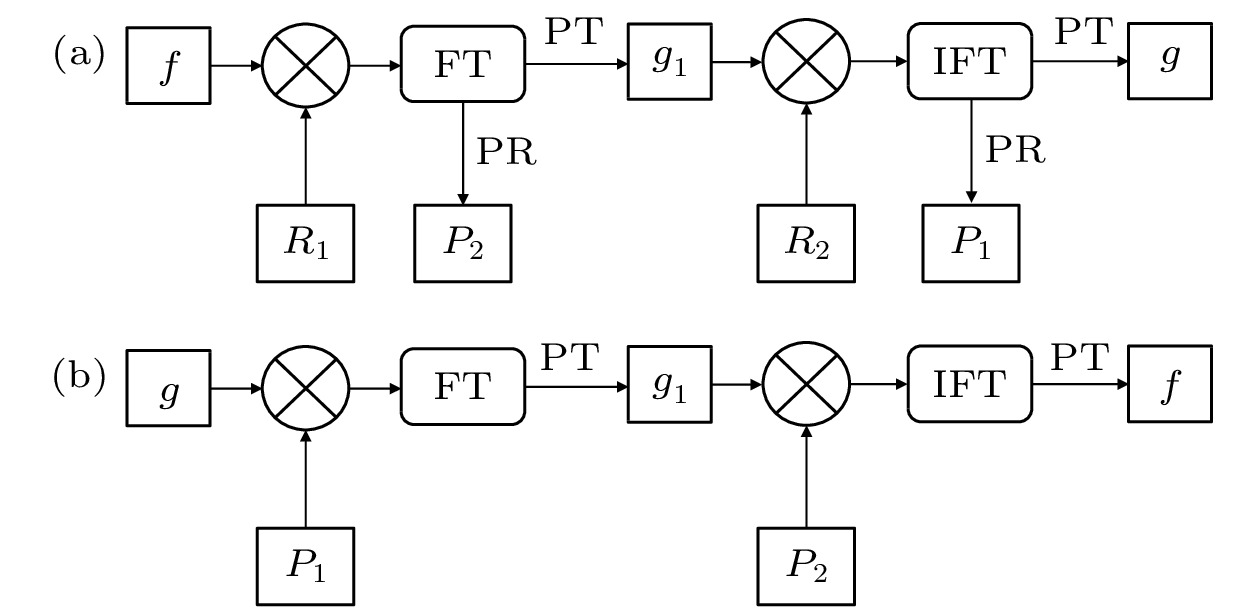
EDITOR'S SUGGESTION
2021, 70 (14): 144202.
doi:10.7498/aps.70.20202075
Abstract +
Most of optical encryption systems are symmetric cryptosystems. The plaintext and the ciphertext in optical image encryption are related linearly. The security of the system needs to be strengthened. The asymmetric cryptosystem based on phase truncated Fourier transforms (PTFT) makes the security of the encryption system greatly improved by its nonlinear phase truncation. Deep learning (DL) as a method of machine learning was proposed decades ago. With the development of computer’s performance, the practicality of deep learning proves to be more and more obvious. Recently, deep learning has been effectively used in many fields such as biomedicine, object detection, etc. The good results have been achieved. In this article proposed is the attack to the PTFT encryption system by deep learning. Through the PTFT encryption system, we construct a plaintext-ciphertext paired image dataset and then train it by residual network (ResNet). There are two problems encountered by the traditional neural network model. One is vanishing or named exploding gradient, which makes training effect difficult to converge and the other is a degradation phenomenon. When continuing to increase the number of layers for a suitable depth model, the model accuracy will decline which is not caused by overfitting. This problem can be solved by the ResNet to a certain extent by directly bypassing and then taking the input information to the output to protect the integrity of the information. The biggest difference between ordinary directly connected convolutional neural networks and ResNet is that the ResNet has many bypass branches that directly connect the input to the subsequent layers, so that the subsequent layers can directly learn the residuals. The ResNet can automatically learn the decryption characteristics of the encryption system. Finally, the test set is used to test the decryption performance of the trained model. The data show that the model can restore the image with high quality and the model has a certain anti-noise ability. Compared with the two-step iterative amplitude recovery algorithm, the the method proposed in this paper can recover high quality image.
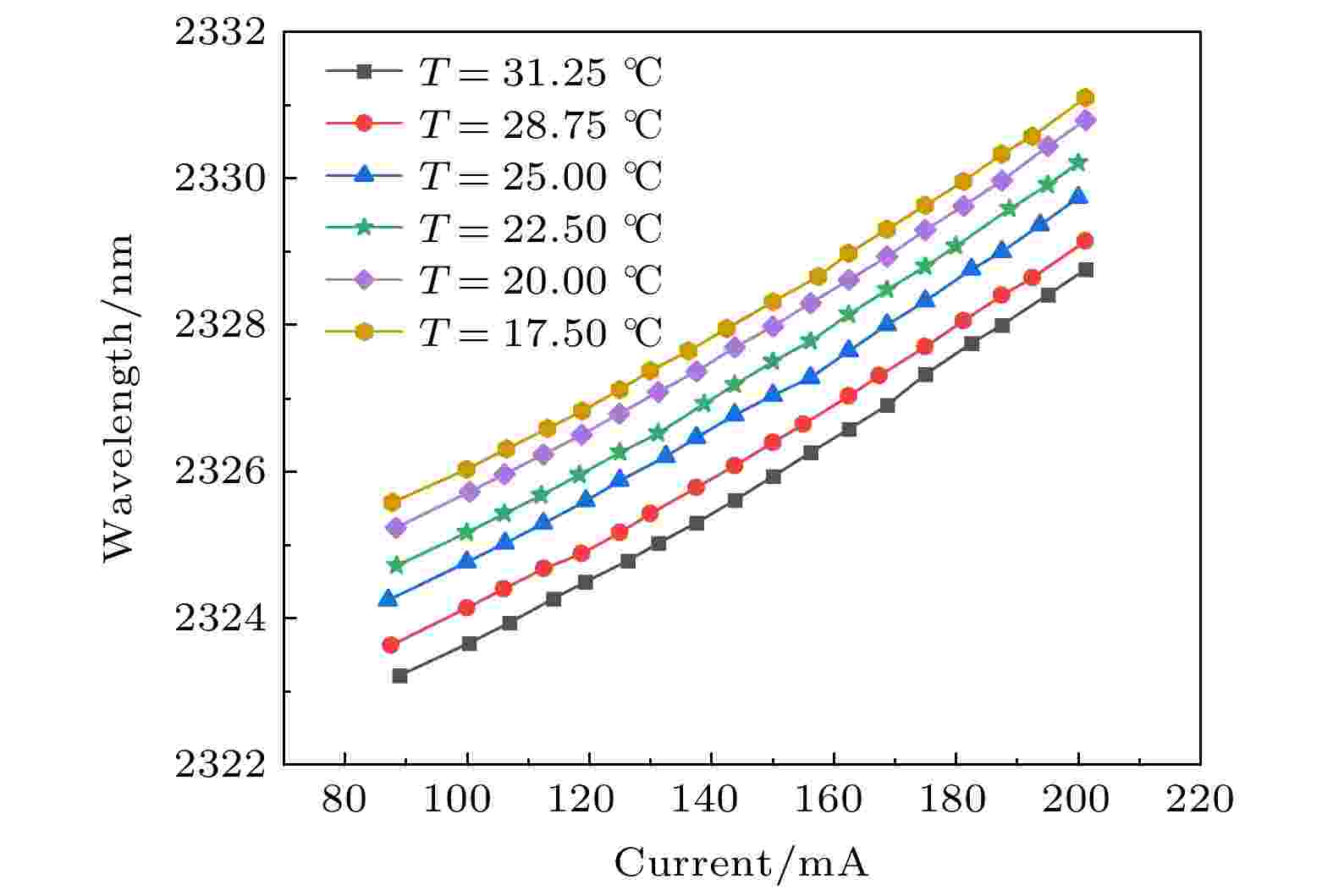
2021, 70 (14): 144203.
doi:10.7498/aps.70.20210286
Abstract +
The interference between overlapping gas absorption lines often occurs in the measurement of multi-component gas mixture with using tunable diode laser absorption spectroscopy (TDLAS). This is also the main problem of the technology in some applications. For instance, in the early application of multi-component gas mixture measurement in coal mines, we found that the absorption lines of carbon monoxide (CO) and methane (CH4) seriously overlapped. The absorption signal of trace CO gas was annihilated and could not be effectively demodulated, especially in the presence of high concentration of CH4. This problem could not be solved just by accurately selecting the spectral lines due to the band absorption of CH4. Therefore, in this paper, we introduce the support vector regression (SVR) model to deal with the interference between CO and CH4absorption lines. The spectral signals of 14 groups of mixed gases with different concentrations of CO and CH4are used as the training sets, and the five-fold cross-validation is adopted to prevent the model from overfitting. After 15 iterations in 30 seconds, the optimal regression model of CO and CH4can be obtained respectively. Furthermore, it is worth noting that based on the experimental data, the linear kernel function is selected to construct the two gas SVR models, and the parameters of the SVR models are optimized by the sequential minimal optimization(SMO) algorithm. With the assistance of the SVR models, the absorption spectra of the two gases can be demodulated effectively, and finally the accurate measurement results are obtained. The measurement results show that the absolute error of trace CO and CH4concentration(volume fraction of gas) are less than 2 × 10–6and 0.2 × 10–2respectively. Meanwhile, the correlation coefficient between the measured values and the actual values of CO and CH4are 0.998 and 0.9995, respectively. In addition, the dynamic stability for each of the two regression models is fully verified by the experiment of the inflation process. Consequently, this method can eliminate the interference between the overlapping spectra, and can fully meet the requirements for accurately measuring the gas mixture. We hope that the SVR model can provide an effective solution for the real-time monitoring of multi-component gas mixture, and thus greatly improving the adaptability of TDLAS technology in the future.
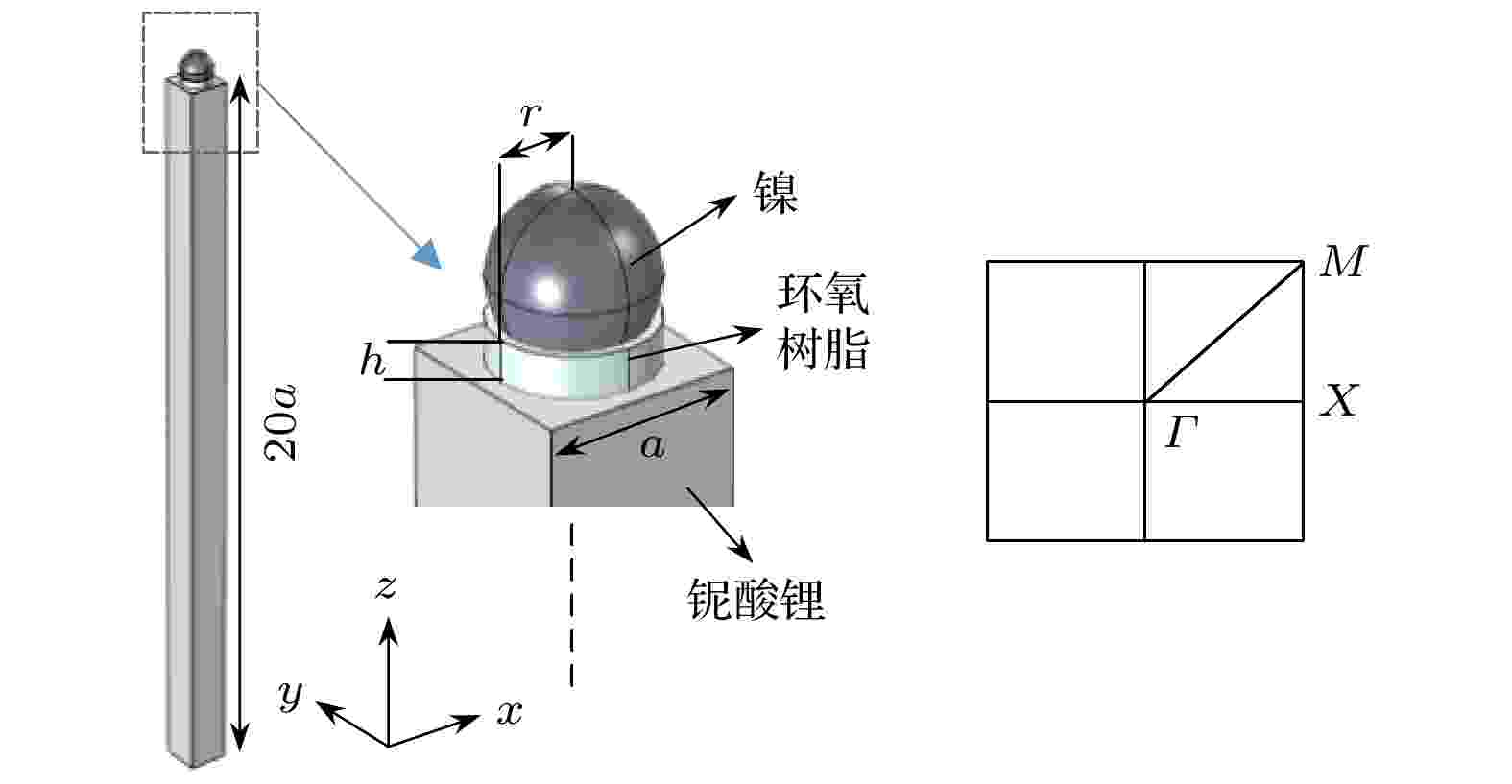
2021, 70 (14): 144301.
doi:10.7498/aps.70.20210165
Abstract +
In the study of acoustic characteristics of micro-scale surface phononic crystal, the band gap characteristics below 100 MHz need to be further optimized. In this work, a piezoelectric surface phononic crystal with a composite column composed of nickel balls and epoxy backing is proposed. The finite element method is used to calculate the band gap characteristics and displacement vector field of the model. The influence of column radius on the band structure is studied, and meanwhile, the effect of the multi-layer composite column structure on the band gap is discussed via increasing the number of elements in the composite column, while the reason for the opening of the high-order band gap is analyzed in detail by combining the vibration mode. Furthermore, the temperature adjustability of the band gap is further studied. The results show that the spherical composite column deposition structure can open a wider complete band gap of surface acoustic wave in a lower frequency range than the existing inverse conical surface phononic crystal structure with the same lattice constant (Hsu J C, Lin F S
2018
Jpn. J. Appl. Phys.
5707LB01
). The restricted cavity mode is easily formed between the hard boundaries with the increase of column radius, which provides a possible way for low-order vibration modes to open high-order band gaps. There exist mode inheritance and energy coupling between adjacent modes, which leads the band gap to flatten and anti-flatten. Moreover, the real-time adjustment of band gap frequency by external temperature field can be realized via introducing the temperature-sensitive material epoxy resin into the structure. The band gap frequency range can be effectively reduced by increasing the number of composite cylinder layers, while the multi-vibrator structure can generate multipole resonance coupling with traveling wave and finally open a complete band gap between high-order frequency bands. This work provides a theoretical reference for analyzing the low-frequency band gap mechanism of micron-scale surface phononic crystal.
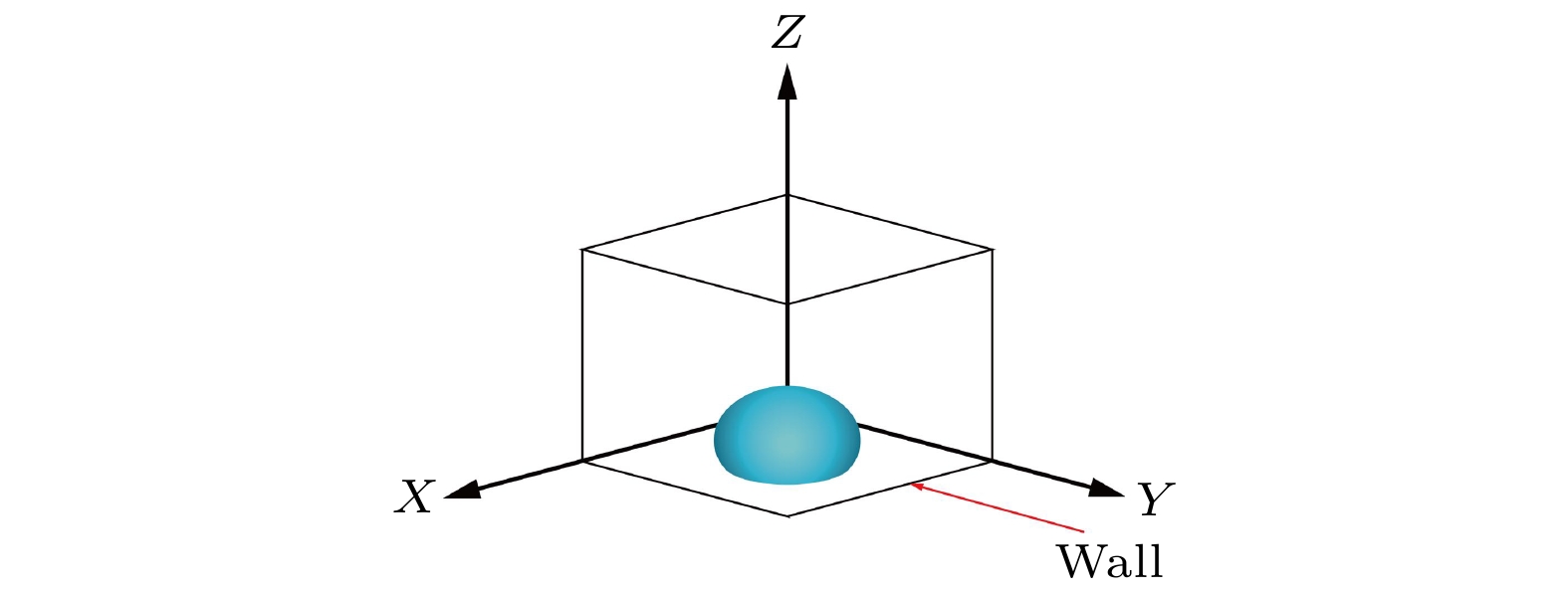
2021, 70 (14): 144701.
doi:10.7498/aps.70.20210161
Abstract +
In order to understand the evolution and flow structure within vertical vibrating droplets on hydrophobic surfaces, a three-dimensional model of the vibrating droplet is developed, and the dynamic contact angle of the vibrating droplet is considered. The numerical simulations are performed for the droplet attached to the vertical vibrating plane by the VOF-CSF method, and the four resonance modes of the droplets are obtained. The evolution of modes (2, 4, 6, and 8), internal flow structures and the variation of the dynamic contact angle are predicted. With the change of the vibration acceleration, the droplet can express a wealth of modes, and the specific mode depends on the frequency of the vibrating acceleration. Based on this model, in this paper the internal flow field structure of the droplet is further analyzed. In mode 2 and mode 4, a Y-shaped flow is generated from the bottom of the droplet, while in mode 6 and mode 8, there is a symmetrical eddy flow. And the higher the order of the resonance mode, the larger the average value of the internal velocity of the droplet is. The dynamic contact angle of the vibrating droplet obviously deviates from the static contact angle, indicating the necessity to consider the dynamic contact angle in simulating the vertical vibrating of droplet. The simulation results are compared with the experimental results from the literature, showing that they are in good agreement with each other.
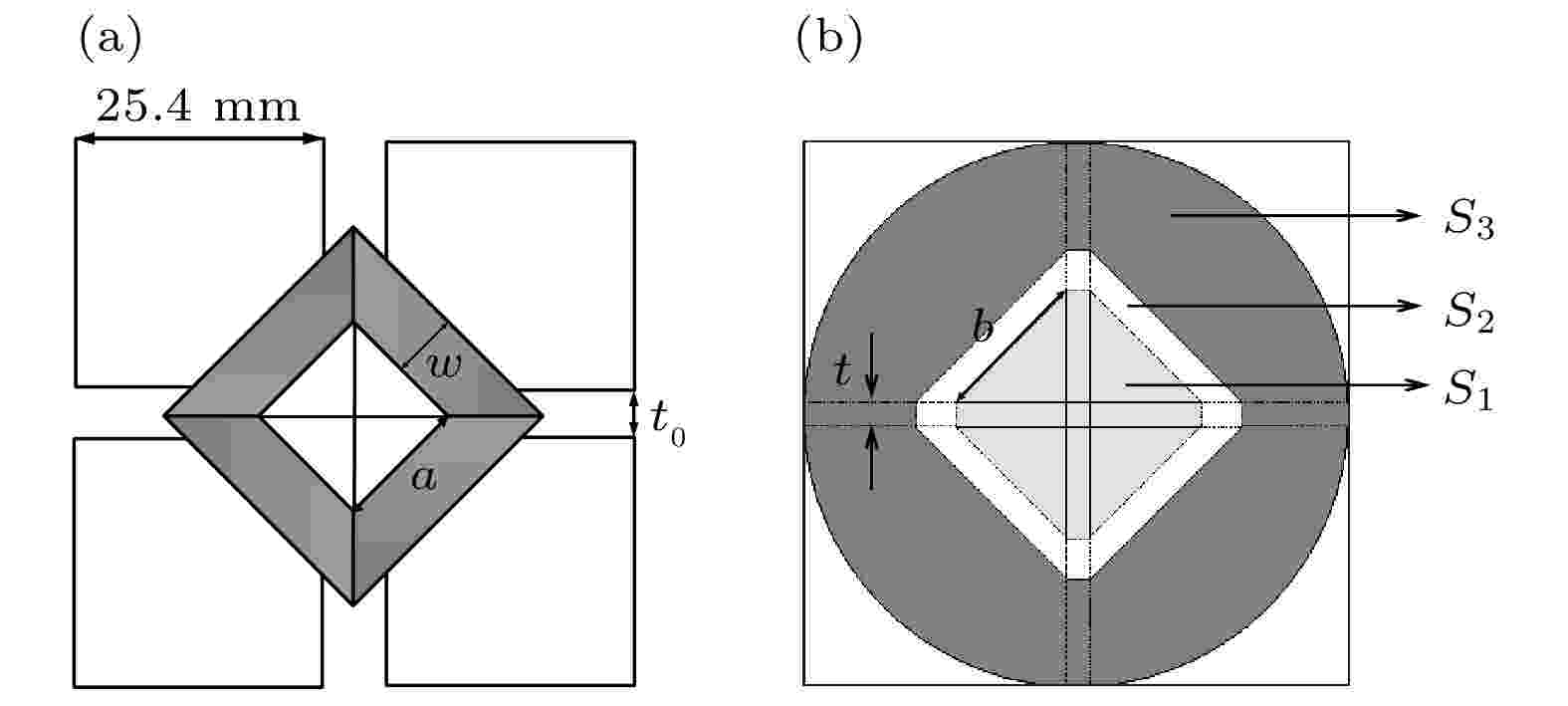
2021, 70 (14): 144702.
doi:10.7498/aps.70.20210006
Abstract +
Since the invention of split sphere multianvil apparatus, the maximum sample size that can be obtained on tungsten carbide (WC) anvils with a certain size has always been a neglected issue. The maximum volume of loaded gaskets and the maximum multianvil cell assembly operating on given size WC anvils are calculated by a simplified geometric model. As a concrete example, the maximum volume of loaded gaskets in different assemblies (18/11, 25/17 (octahedral edge-length/anvil truncation edge-length, in millimetre)) and different initial shapes of octahedrons (octahedron chamfered or not) running on WC anvils with 25.4 mm edge-length are calculated. The maximum initial sizes of gaskets in different assemblies are also calculated according to the maximum volume of loaded gaskets. Using the pyrophyllite octahedron as the pressure transmission medium, the pressure calibration of 14/8, 18/11, and 25/17 assembly are carried out on WC cubes, of which the edge-length is 25.4 mm, to verify the calculated results. The cell pressure is calibrated by in situ observing resistance change caused by phase transition of pressure calibration material at high pressure. All assemblies run stably and no blow-out phenomenon occurs. The experimental results show that the pressure transfer efficiency of 18/11 and 25/17 assembly with chamfered octahedron are better than previous reported results in the same pressure range. The experimental results also indicate that the calculations of the gasket in this work are valid. And the 25/17 assembly with chamfered octahedron can run stably on WC cube with 25.4 mm edge-length. In addition, using graphite tubes as heater, heating structure designs of different assemblies (14/8, 18/11, 25/17) are completed, in which the 14/8 assembly can achieve the highest temperature of 2300 ℃. The diameter of sample chamber is almost one centimeter in 25/17 assembly. This work contributes to the development of assembly techniques for secondary anvil made of polycrystalline diamond materials to obtain larger sample volumes under higher pressure conditions.
PHYSICS OF GASES, PLASMAS, AND ELECTRIC DISCHARGES
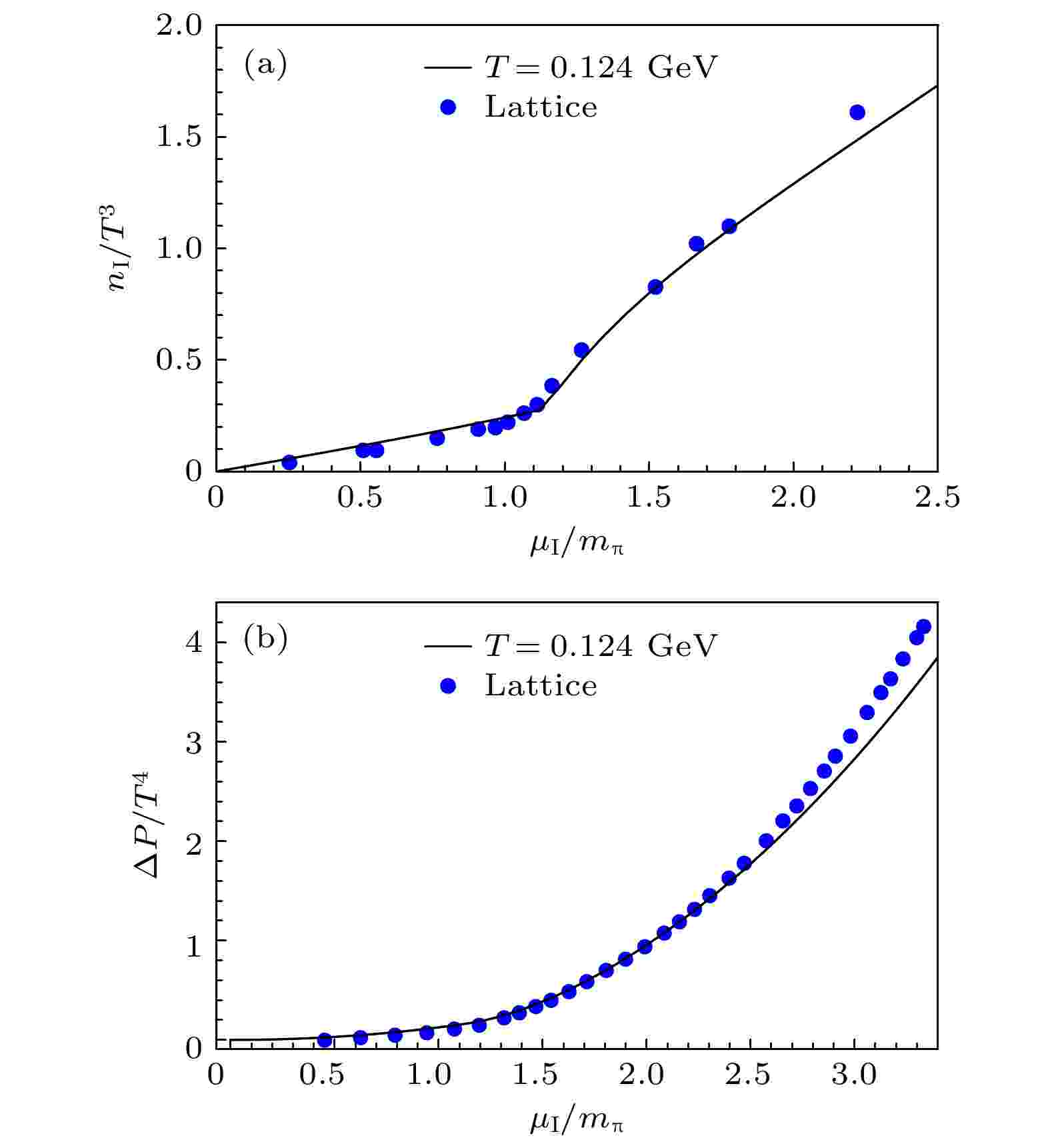
2021, 70 (14): 145101.
doi:10.7498/aps.70.20210132
Abstract +
The effects of temperature and baryon chemical potential on equation of state and thermodynamics of isospin imbalanced QCD matter are investigated in the framework of two-flavor Nambu−Jona-Lasinio model. The equation of state at zero temperature and baryon chemical potential as well as the isospin density and normalized pressure at finite temperature are shown to be consistent with the lattice data. We also find that the energy per isospin increases monotonically with the increase of isospin density at vanishing temperature and baryon chemical potential, while it first decreases and then increases with the augment of isospin density, behaving as a non-symmetric parabolic curve. Finally, we compute the sound velocity and find that it is discontinuous at the phase transition point for finite temperature and/or baryon chemical potential. In particular, the sound velocity in the superfluid phase is distinctly larger than that in the ordinary nuclear matter and quark matter, while the temperature and baryon chemical potential included in the superfluid phase makes the equation of state softer and the sound velocity slower.
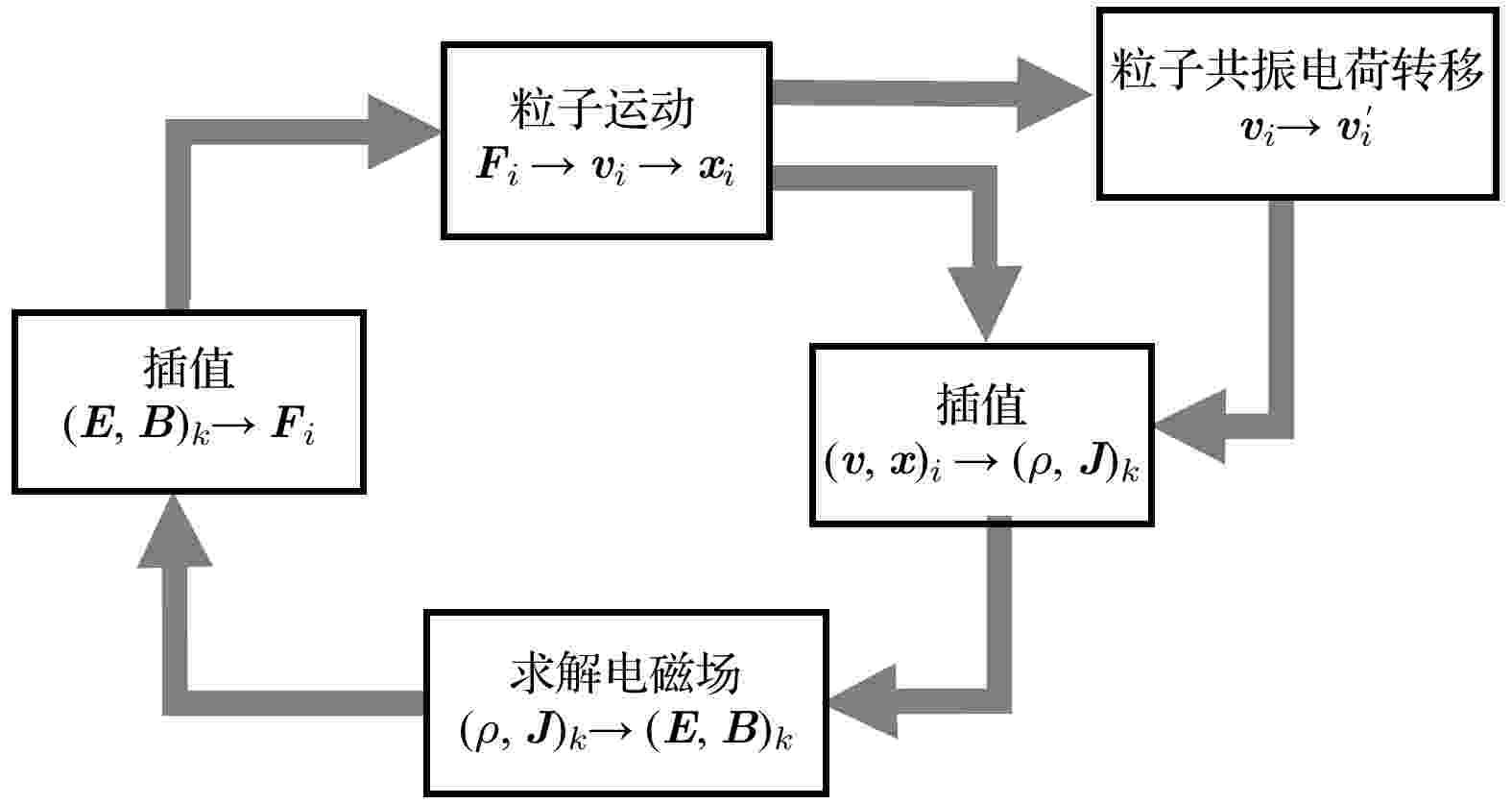
2021, 70 (14): 145201.
doi:10.7498/aps.70.20210105
Abstract +
The electric ion extraction, which plays an important role in productivity and abundance of product, is a critical step in laser isotope separation (LIS) technology. Several collision processes happen during the electric ion extraction, such as resonant and non-resonant charge exchange between ion and atom, the secondary ionization process and the ion-electron recombination. The resonant charge exchange process between target isotope ions and no-target background atoms is one of the major reasons of product contamination. As a result, the study of ion extraction with the consideration of resonant charge exchange process is essential. However, the resonant charge exchange process in ion extraction has not received enough attention. Besides, contradictory findings have been deduced in published studies. Therefore, it is necessary to clarify the effect of resonant charge exchange process in the electric ion extraction. In this article, the particle-in-cell (PIC) method and preprocessing hybrid-PIC method are adopted in both one- and two-dimensional numerical simulation. The preprocessing hybrid-PIC method is a calculation scheme by which accurate results can be obtained with less computational consumption. In this calculation scheme, the PIC method and hybrid-PIC method are used sequentially in different stages of ion extraction process. One-dimensional parallel type simulation cases are carried out under the circumstances of different initial plasma densities, applied voltages and background atom densities. The results show that the resonant charge exchange process happens in both shield layer and sheath layer. The ionic resonant charge exchange proportion in shield layer and sheath layer are related to the ion extraction time and average travel length in background vapor, respectively. Besides, they are proportional to the resonant charge exchange cross section and background atom density. And an empirical formula for deriving the resonant charge exchange ratio roughly is proposed. Two-dimensional simulations are carried out in four electrode configurations: parallel type, alternately biased parallel type, Π-type, and M-type. The extraction mechanisms are discussed and compared with each other. The simulation results show that M-type electrode configuration has the minimum resonant charge exchange ratio and extraction time among the configurations above. The results and conclusions provide an important reference for designing the LIS device.
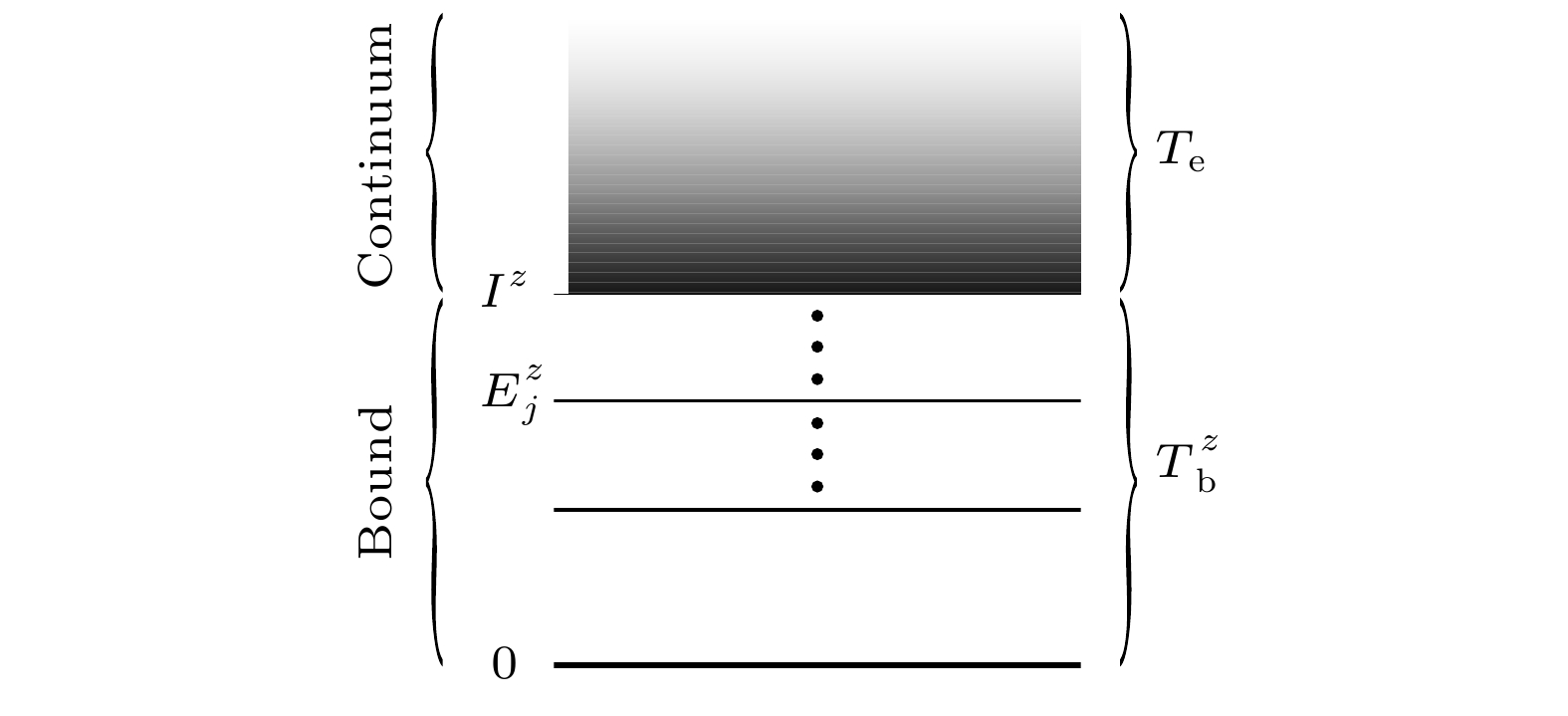
2021, 70 (14): 145202.
doi:10.7498/aps.70.20202119
Abstract +
CONDENSED MATTER: STRUCTURAL, MECHANICAL, AND THERMAL PROPERTIES

2021, 70 (14): 146302.
doi:10.7498/aps.70.20202196
Abstract +
Ferroelectric random access memory (FeRAM) has been regarded as a promising technology for next-generation nonvolatile storage due to its excellent data storage performance and nonvolatile storage characteristics. However, fatigue degradation properties seriously impede the development and large-scale commercial use of FeRAM. In this paper, the interaction mechanism and enhancement of ferroelectric fatigue in lead zirconate titanate (PZT) thin film are investigated by the first-principles calculations (DFT). Theoretical calculations suggest that the coupling between oxygen vacancies and 180° domain walls in PZT is responsible for ferroelectric fatigue. Oxygen vacancies are more likely to be formed closer to domain wall, the “pinning” between oxygen vacancies and domain wall makes the migration of domain wall difficult, resulting in the suppression of polarization reversal and ultimately fatigue in ferroelectric thin film. The insertion of Ba(Mg1/3Nb2/3)O3(BMN) can absorb the oxygen vacancies in PZT and reduce the concentration of oxygen vacancies, and in doing so, the ferroelectric fatigue problem caused by the “pinning” effect of the oxygen vacancies can be eliminated. Moreover, the PZT thin films are deposited on Pt/Ti/SiO2/Si(100) by the sol-gel method with using BMN buffer layer. The remnant polarization (Pr

2021, 70 (14): 146401.
doi:10.7498/aps.70.20210256
Abstract +
Amorphous alloys exhibit unique physical and mechanical properties, which are closely connected with their microstructural heterogeneity. The correlation between structural heterogeneity and mechanical properties is one of the important issues of amorphous alloys. Micro-alloying is an effective way to tune the mechanical and physical properties of amorphous alloys. In the present study, Zr50–xCu34Ag8Al8Pdx(x= 0 and 2) amorphous alloys with ability to form excellent glass are chosen as model alloys. The evolutions of heat flow and shear modulus in different states (as-cast, relaxed and crystalline) with temperature of Zr50–xCu34Ag8Al8Pdx(x= 0 and 2) glass system are studied by differential scanning calorimetry (DSC) and electromagnetic-acoustic transformation (EMAT) technique, respectively. The experiment demonstrates that a decrease of the shear modulus is accompanied by the endothermic heat flow and vice versa. The correlation between the heat flow and shear modulus is investigated according to the interstitialcy theory. The calculations of the interstitialcy defect concentration and activation energy spectra suggest that the microstructure remains stable at relatively low temperatures. When temperature increases, the interstitialcy defect structure is activated. Compared with that in the as-cast state, the interstitialcy defect concentration in the relaxed state is reduced by structural relaxation, indicating that temperature-dependent shear modulus softening is inhibited. At temperatures above glass transition temperature, a rapid growth of interstitialcy defect concentration results in the accelerated shear softening, which is accompanied by significant endothermic heat flow. It is noted that the minor addition of palladium reduces the interstitialcy defect concentration in the Zr50–xCu34Ag8Al8Pdx(x= 0 and 2) metallic glass systems. It is suggested that the introduction of Pd reduces the atomic mobility and increases the characteristic relaxation time. In parallel, the change of shear modulus as a function of the aging time (below the glass transition temperature) is studied by using EMAT equipment. The results indicate that the interstitialcy defect concentration decreases in the physical aging process, which is accompanied by an increase of shear modulus. The interstitialcy defect concentration and shear modulus change towards the quasi-equilibrium state with aging time increasing. A reduction of the interstitialcy defect concentration leads to a decrease of the shear modulus change upon microalloying by Pd into Zr50–xCu34Ag8Al8Pdx(x= 0 and 2) metallic glass system.
CONDENSED MATTER: ELECTRONIC STRUCTURE, ELECTRICAL, MAGNETIC, AND OPTICAL PROPERTIES
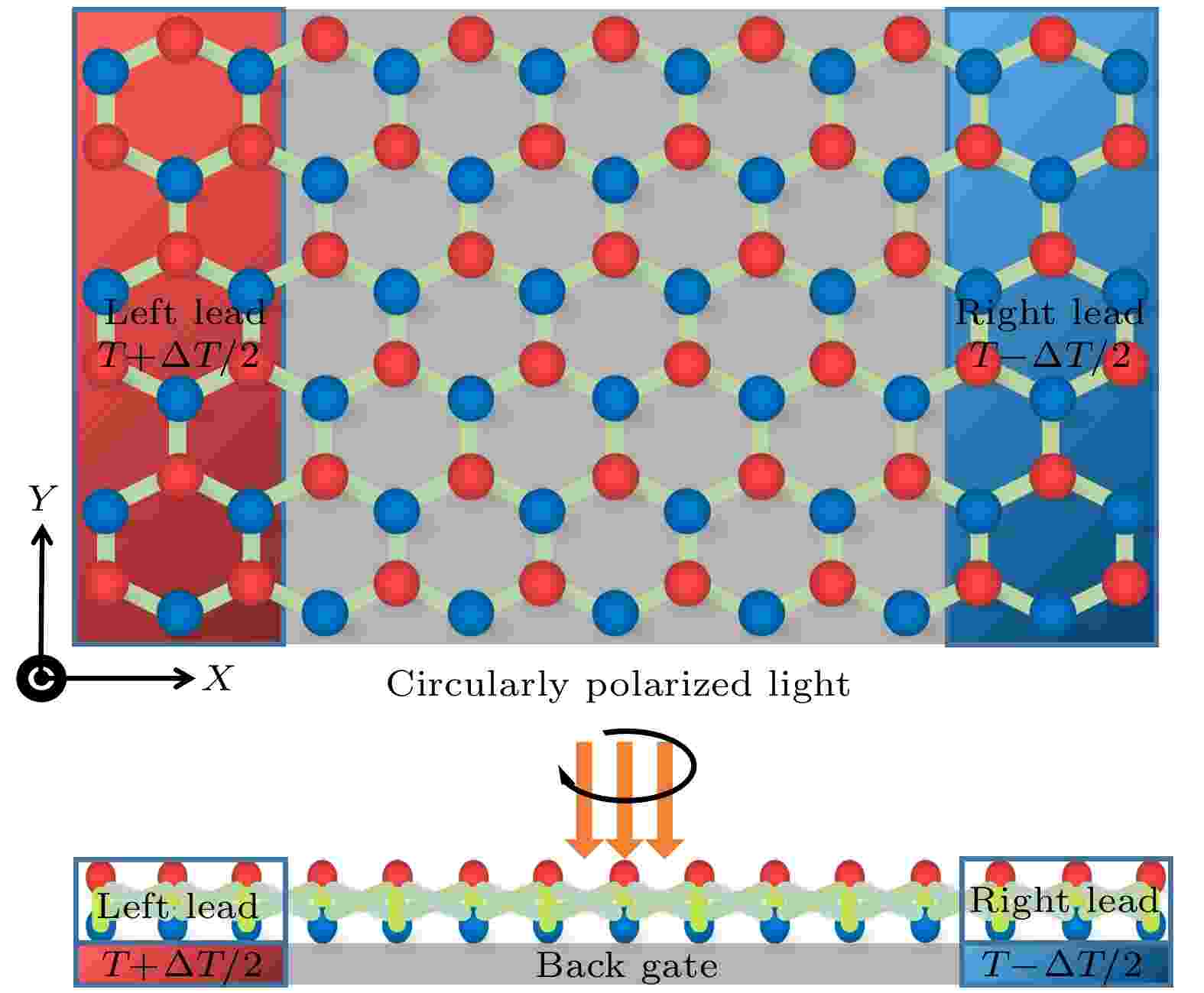
EDITOR'S SUGGESTION
2021, 70 (14): 147301.
doi:10.7498/aps.70.20210197
Abstract +
The major challenge of spintronics lies in how to generate, manipulate, and detect spin current. Multiple methods, such as using magnetic materials, magnetic field, and polarized light field to manipulate the spin of electrons, have been proposed. Owing to the possible applications in spintronic devices, there is currently great interest in the field of spin caloritronics, which focuses on the interplay of spin and heat currents. Stanene is a type of two-dimensional topological insulator consisting of a single layer of Sn atoms arranged in a hexagonal lattice. In this paper, the effects of light and electric fields on the spin-dependent thermoelectric effect of the stanene nanoribbon are studied theoretically based on the non-equilibrium Green’s function method. The results show that the properties and intensity of the thermoelectric current can be effectively controlled by the intensity and the polarization direction of the circularly polarized light field. Under the joint action of a strong circularly-polarized light field and an electric field, the stanene can transform from a quantum spin-Hall insulator into a spin-polarized quantum Hall insulator. When the left-circularly-polarized light field is applied, the spin-down edge states of stanene undergo a phase transition to form a bandgap, and a 100% spin-polarized spin-down current driven by temperature gradient can be obtained. When the right-circularly-polarized light is applied, the edge states of spin-up electrons are destroyed, and a completely polarized spin-up thermal current can be generated. In the weak external field, the properties of the edge state do not change, and the system does not output a thermoelectric current. In addition, the study shows that the intensity of the thermal spin current is related to the width of the bandgap, and a moderate increase in temperature can significantly increase the peak value of the current, but the higher equilibrium temperature and temperature gradient will restrain the spin thermoelectric effect.
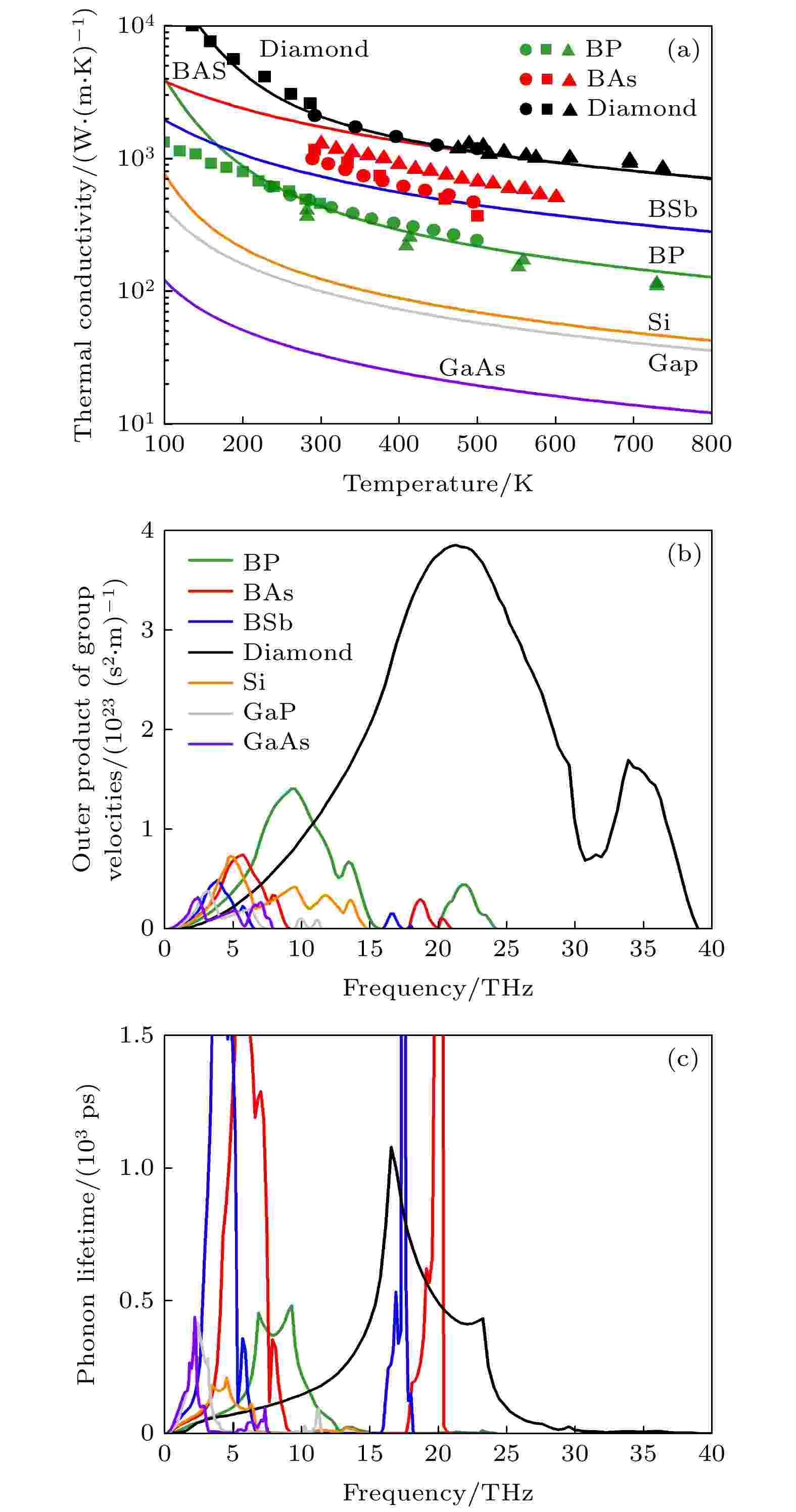
COVER ARTICLE
2021, 70 (14): 147302.
doi:10.7498/aps.70.20210797
Abstract +
Over the past half-century, according to Moore’s law, the sizes of transistors continue shrinking, and the integrated circuits have approached to their physical limits, which puts forward higher requirements for the thermal dissipation capacity of material. Revealing the physical mechanisms of heat conduction in semiconductors is important for thermal managements of devices. Experimentally, it was found that boron arsenide has a very high thermal conductivity compared with diamond, and boron arsenide has lattice constant close to silicon’s lattice constant, which can be heterogeneously integrated into silicon to solve the thermal management problem. However, group III-V boron compounds show abnormal thermal conductivities: the thermal conductivity of boron arsenide is significantly higher than that of boron phosphide and boron antimonide. Here, we use the first-principles calculation and the Boltzmann transport equation to study the thermal conductivity properties of the group III-V boron compounds. Comparison between the IV and III-V semiconductors shows that the high thermal conductivity of boron arsenide is due mainly to the existence of a large frequency gap between the acoustic and the optical branches. The energy sum of two acoustic phonons is less than energy of one optical phonon, which cannot meet the energy conservation requirements of three-phonon scattering, and then seriously restrict the probability of scattering of three phonons. The high thermal conductivity of diamond is due mainly to its great acoustic phonon group velocity. Although the boron phosphide also has a relatively large acoustic phonon group velocity, the frequency gap is relatively small, which cannot effectively suppress the three-phonon scattering, so the thermal conductivity of boron phosphide is less than that of boron arsenide. Although the frequency gap of boron antimonide is similar to that of boron arsenide, the thermal conductivity of boron antimonide is lower than that of boron arsenide due to its smaller acoustic phonon group velocity and larger coupling matrix element. The research provides a new insight into the design of semiconductor materials with high thermal conductivities.
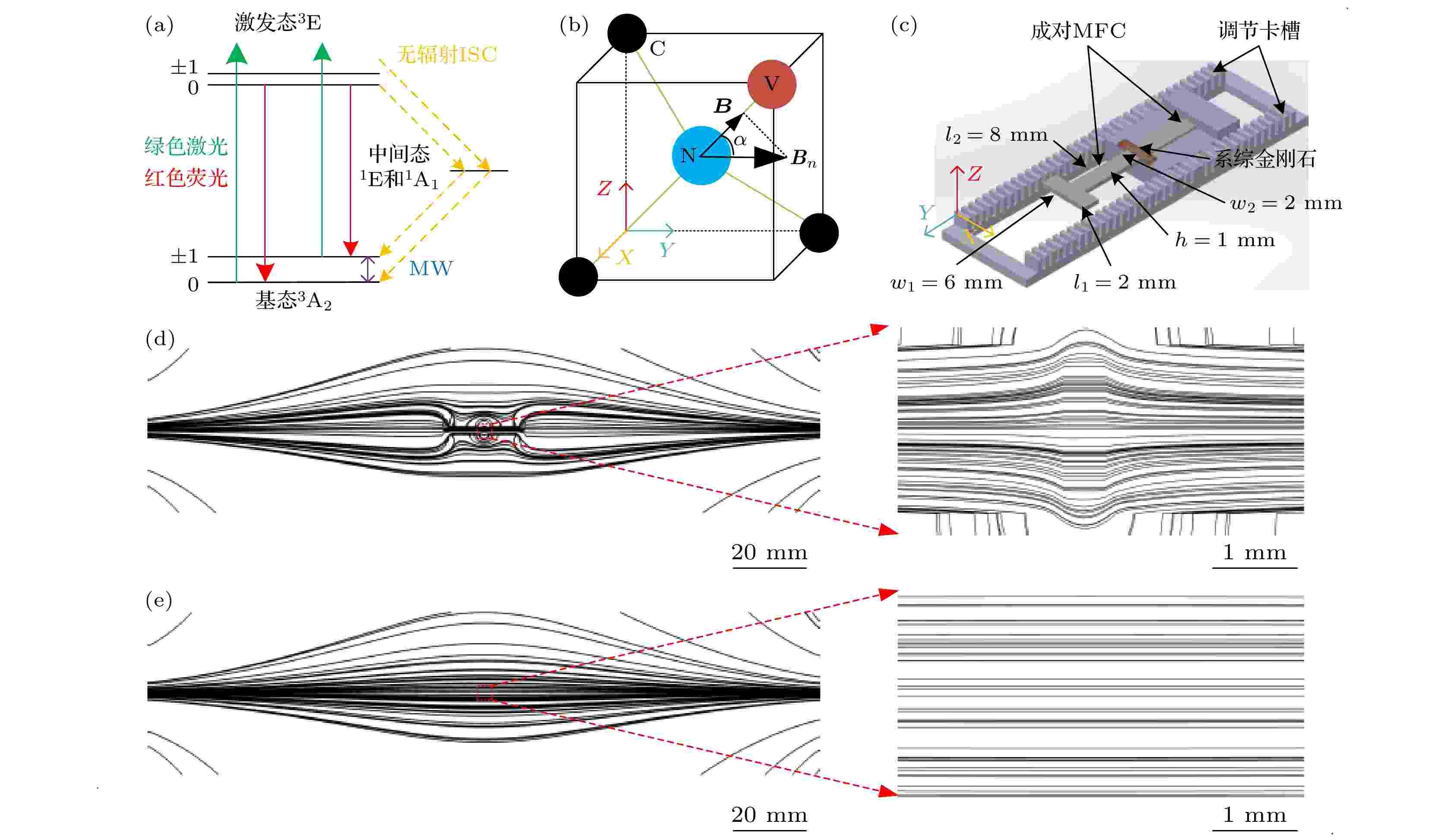
2021, 70 (14): 147601.
doi:10.7498/aps.70.20210129
Abstract +
The high-sensitivity magnetic sensor is the key to the weak magnetic and extremely weak magnetic detection imaging. In this paper, based on ensemble nitrogen-vacancy (NV) color center in diamond, a wide-field magnetic field distribution imaging system combined with the magnetic flux concentrator (MFC) is built for enhancing the magnetic detection. The paired T-shape chip MFC structures are designed and prepared based on the simulation of magnetic flux concentration effect, and the enhancement of magnetic field of MFC is verified by continuous wave optical detection magnetic resonance (CW-ODMR) imaging technology. When the gap width between the MFCs is 1.0 mm, the magnetic enhancement factor is about 10.35. To verify the effectiveness of the magnetic enhancement effect of the MFC, The magnetic enhancement effects are also measured under different magnetic field strengths and different gap widths. The magnetic sensitivity of the system increases from 1.10 nT/Hz1/2to 0.30 nT/Hz1/2. By comparing the simulations with the measurements, the relationship between the measured magnetic enhancement multiple and the gap width can be obtained, and the better magnetic enhancement capability and sensitivity of the experimental system are also estimated. When the MFC’s gap width is 0.5 mm, the corresponding magnetic enhancement factor is increased to 18.21, and the corresponding magnetic sensitivity is 0.25 nT/Hz1/2. These results show that the magnetic detection sensitivity of the ensemble NV in diamond can be effectively improved based on magnetic flux concentration effect, which provides a reference for the applications of precision quantum measurement technology in weak magnetic and extremely weak magnetic detection.
INTERDISCIPLINARY PHYSICS AND RELATED AREAS OF SCIENCE AND TECHNOLOGY

2021, 70 (14): 148201.
doi:10.7498/aps.70.20202240
Abstract +
Brownian motion refers to the endless random motion of nanometer-to-micron particles suspended in a fluid. It widely exists in nature, and is applied to energy, biology, chemical industry, environment and other industries. As the Brownian motion of the object decreases from the micron level to the nanometer level, the boundary conditions of the particle motion no longer strictly follow the stick hydrodynamic boundary conditions, but are closer to the slip boundary theory, meanwhile, the interaction between particles and solvents has increasingly important influence on particle dynamics. Molecular dynamics simulation is an important means to study nanofluids, which can not only capture the microscopic details of the interactions between particles and solvent molecules in nanofluids, but also have high potential function accuracy. In this paper, an all-atom model of the diffusion of Cu nanoparticles of different sizes in water is established by using the rigid TIP4P/2005 water molecule model as solvent, the dynamic viscosity from the TIP4P/2005 model is in good agreement with the experimental result, which is verified by the Green-Kubo formula. The FCC lattice structure is used to construct Cu particles of 0.5 nm, 1.0 nm, 1.5 nm, 2.0 nm in size, and the interaction between atoms in the particle is described by the EAM potential. The translational diffusion coefficient of particles is fitted by the single particle tracking algorithm and the least square method, the rotational diffusion coefficient of particles is obtained by quaternion transformation. The diffusion coefficient and friction factor of the particles are calculated, and the friction factor is compared with the result under the stick hydrodynamics boundary conditions and the result under the slip boundary conditions. It is found that the frictional factors of translation and rotation of nano-particles lie between the theoretical values predicted by the two boundary conditions. The radial distribution functions of water molecules around nanoparticles of different sizes are calculated, we find that the smaller the particle size, the more obvious the adsorption of solvent molecules will be, and the water molecular layer on the particle surface will increase the effective volume of particles and make the calculation result of friction factor larger. The effect of solvent adsorption on the effective hydrodynamic radius of particles cannot be ignored when calculating the friction coefficient of Brownian motion of nano-particles, especially when the particle radius is close to the solvent radius. In Brownian dynamics, viscous resistance and stochastic force are constrained by fluctuation dissipation theorem, and a reasonable selection of particle friction factor can provide theoretical basis for the improvement of Brownian dynamics.
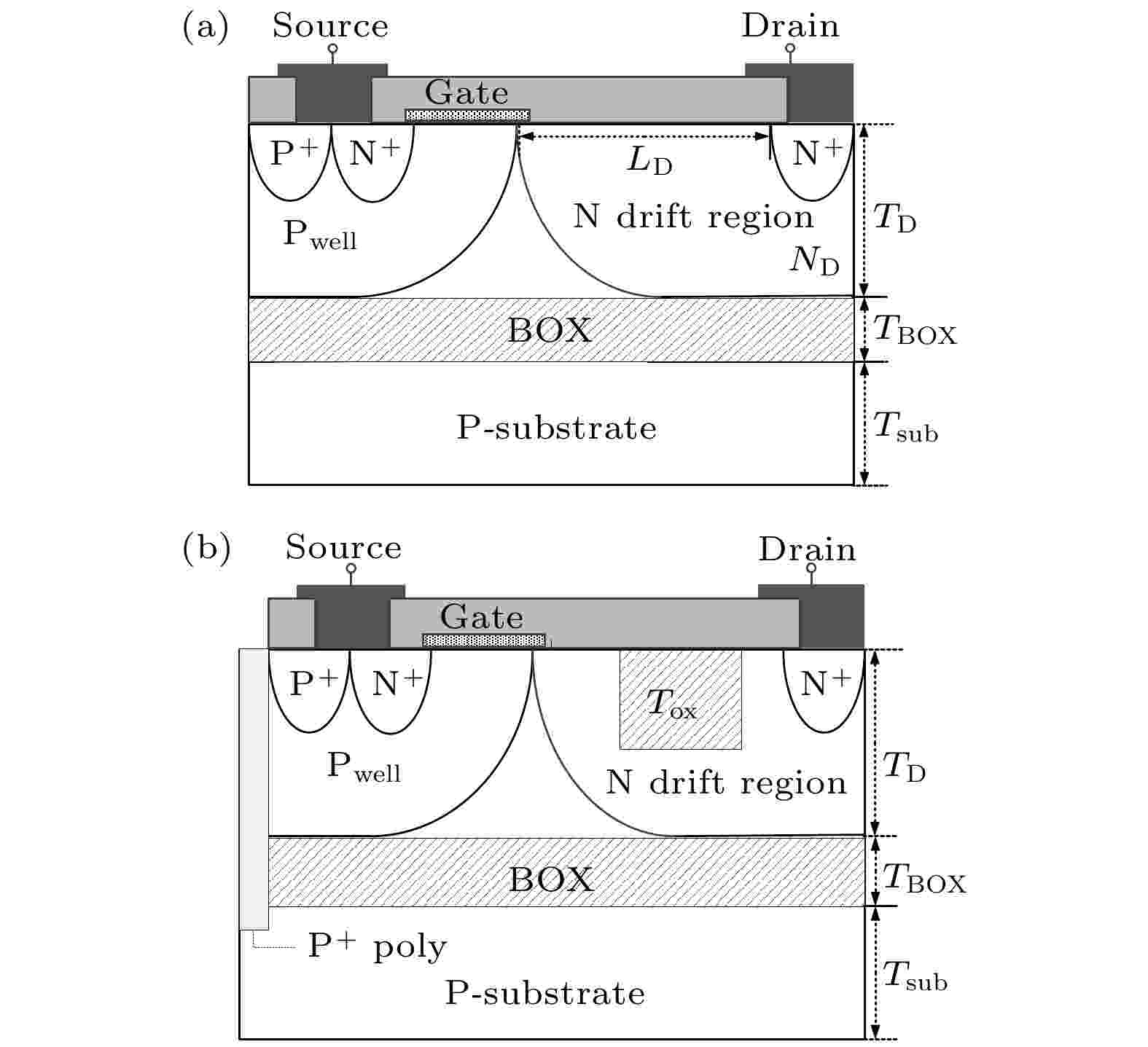
2021, 70 (14): 148501.
doi:10.7498/aps.70.20202065
Abstract +
With the rapid development of the traditional inorganic semiconductor industry, the improvement of its electrical performance is gradually approaching to the limit. It is difficult to continue to improve the performance, lessen the size, and reduce the cost. Therefore, organic semiconductor materials and devices with simple process and low cost have been found and gradually become a new research hotspot. Although organic semiconductor materials and devices are developing rapidly, their electrical properties, such as carrier mobility, are considerably inferior to those of inorganic semiconductors, and their research direction and application prospect are relatively fixed and single. They are developed only in display, sensing, photoelectric conversion and other fields, but the researches on switching power devices, integrated circuits and other fields are still relatively blank. At the same time, power devices are used only in the field of inorganic semiconductors. Therefore, in order to expand the research direction of organic semiconductors and power devices at the same time, a novelsilicon on insulator lateral double-diffused metal oxide semiconductor (SOI LDMOS)power device is reported in this paper. Unlike the SOI LDMOS power devices in traditional inorganic semiconductors, this novel device can be used in the field of organic semiconductors by combining with insulated flexible substrates, which provides a new possibility for the research direction of organic semiconductors. In this paper, both simulation and experiment verify that specific on-resistance (RON,sp) and threshold voltage (VTH) do not change significantly when the conventional SOI LDMOS lacks the substrate electrode, but the breakdown voltage decreases by about 15% due to the absence of the substrate electrode or the longitudinal electric field. In response to this phenomenon, in this paper proposed is a novel SOI LDMOS power device that possesses surface substrate electrodes and drift zone oxide trenches. This novel device can provide electrodes for the substrate again, optimize the horizontal and vertical electric field, and significantly change neither of theRON,spand theVTH. At the same time, the breakdown voltage (BV) of conventional SOI LDMOS is increased by 57.54%, which alleviates the adverse effects caused by the application in the field of organic semiconductors. This novel SOI LDMOS power device provides the possibility of applying traditional power semiconductors to the research of organic semiconductors, and has innovative significance for expanding the organic semiconductor research.

2021, 70 (14): 148802.
doi:10.7498/aps.70.20210298
Abstract +
Hydrogen production through electrolyzing water can transfer the energy from solar energy, wind energy and other sustainable energy to hydrogen, a clean energy carrier with high energy density. The NiP2has attracted much attention as a cheap electrocatalyst with high catalytic performance for hydrogen evolution reaction (HER). In this paper, the adsorption energy, Gibbs free energy and exchange current densities at different sites on NiP2(100) surface are calculated. On this basis, the effect of strain and doping on the HER catalytic performance of NiP2are studied. By calculation, we find that when H is adsorbed on the top site of P atom on NiP2(100) surface, the exchange current density is the closest to the top of volcanic curve, so the top site of P atom on NiP2(100) surface is the catalytic active site. The effect of doping and strain on the catalytic performance of NiP2are analyzed. 1) According to the range of strain produced by the common experimental technology, the effects of 1% and 3% tensile and compressive strain are calculated. It is found that 1% compressive strain can improve the catalytic performance of NiP2, while when 3% compressive strain or a 1% or 3% tensile strain is applied, the catalytic performance of NiP2is not enhanced. 2) The effects of doping transition metal elements (Co, Fe, Mn, Mo, Cu, W, Cr) and non-metallic elements (N, C, S) on the catalytic performance of NiP2are calculated. It is found that doping non-metallic element S can significantly improve the HER catalytic performance of the top site of P atom, while the doping of transition metal elements Mn, Mo, W, Co, Cr, Fe, Cu and non-metallic elements N, C have no effect on this site. The doping of transition metal element (catalytic activity: Mn > Mo > W > Co > Cr > Fe > Ni) Mn can make the catalytic performance of inactive site improved to that of the active site, thus indirectly improving the catalytic performance of NiP2. Our work reveals the micro mechanism of the effect of doping and strain on the performance of HER electrocatalyst, which provides a new perspective for designing the high performance HER electrocatalyst.

2021, 70 (14): 148901.
doi:10.7498/aps.70.20210055
Abstract +
In our study, the unidirectional pedestrian flow in an L-shaped corridor is taken as the research object, and the pedestrian turning behavior is studied based on controllable experiments and micro simulations. First of all, three experimental scenarios, namely, no obstacles in the turning zone, diagonal layout of obstacles along the turning zone, and diagonal layout of obstacles in the vertical turning zone, are constructed. Behavioral characteristics such as pedestrian movement trajectory and velocity distribution are analyzed through controllable experiments of pedestrians. Then, a velocity correction model based on the Voronoi diagram is constructed, and the turning rules of pedestrians passing through a 90-degree L-shaped curve are embedded in the model. Finally, simulation research is conducted on the scene with both obstacles and asymmetric L-shaped corridors as well as the scene with neither of them to simulate and reproduce the turning behavior of pedestrians, and analyze the distributions of pedestrian velocities and individual densities at different stages. The research shows that when pedestrians move in a normal non-panic status, they rarely present disorderly behavior and always approach to the inside of the corner of the L-shaped corridor. In the turning area, pedestrians always follow their original moving mode to pass through the corner like a stable arc. And in the process of moving, pedestrians do not move in a straight line, but keep shaking back and forth for zipper effect. Besides, in the process of turning, the longer the distance from the center of the corner, the longer the distance of the pedestrian around the arc will be. And the L-shaped corridor can be divided into vertical straight area, transition area, turning area, and horizontal straight area. When pedestrians pass through the turning walking area, the “invisible bottleneck” phenomenon and the “curved triangle idle area” phenomenon can be observed. Besides, the streamline compression and multiple rows of pedestrian track clusters can be seen in the region. According to the characteristics of pedestrians walking through the L-shaped corridor, the turning rules of pedestrians are made, and the scene with both of obstacles and asymmetric L-shaped corridor as well as the scene with neither of them is simulated. Then, through the pedestrian simulation by using our model, the turning behavior of pedestrians passing through curve like a smooth arc can be effectively reproduced. Moreover, the “invisible bottleneck” phenomenon and the “curved triangle idle area” phenomenon in the turning walking area can be seen in the simulation. At the same time, when the pedestrian flow passes through the four areas of the L-shaped corridor successively, the velocity distribution is consistent with the experimental data of the pedestrian, showing an increasing-decreasing-increasing “wavy” change characteristic. The simulation model is also used to simulate the local density change of pedestrians due to the turning behavior, which verifies the unity of pedestrian velocity and local density change. The cognition of invisible bottleneck is helpful in rationally utilizing and designing the L-shaped corridor turning area.
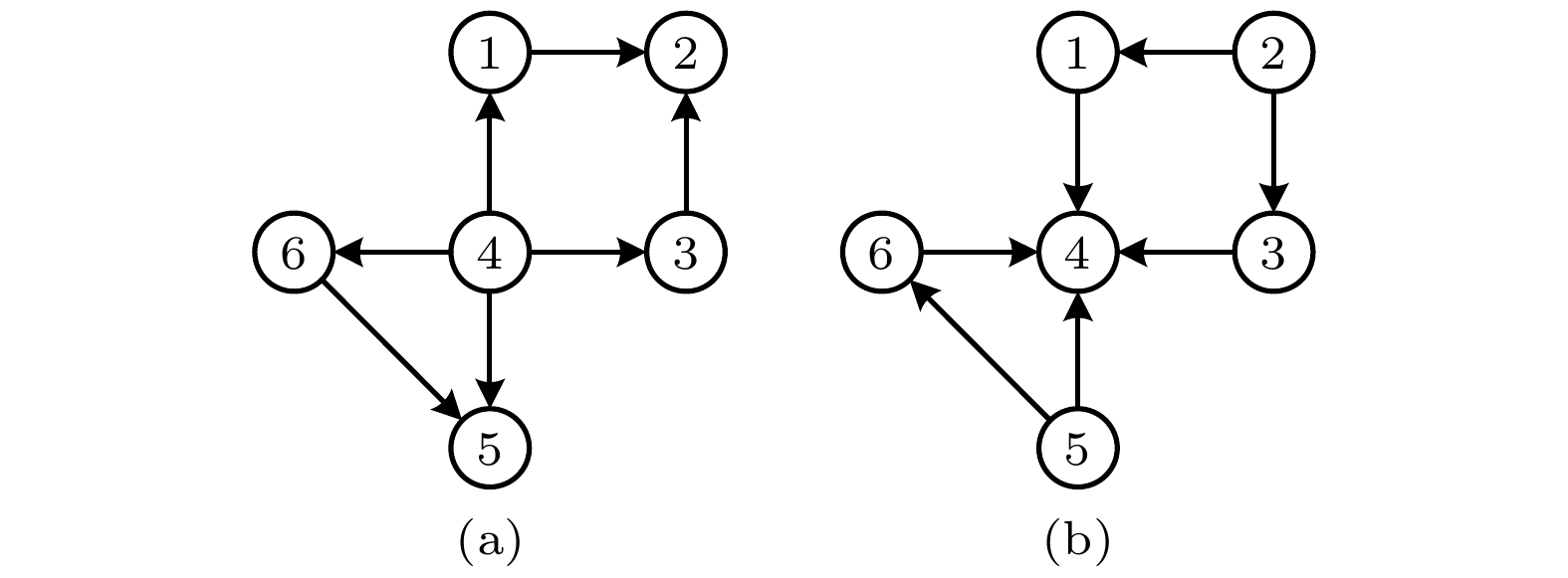
2021, 70 (14): 148902.
doi:10.7498/aps.70.20201831
Abstract +
It is undisputed that complex networks are used to describe the interaction between large-scale complex systems. Different edges have different effects on network controllability. When some edges in a network are attacked or destroyed, the network controllability may be affected very little; when some other edges are attacked, network controllability may be affected very greatly, even results in the uncontrollability of the network. Which edges failure will affect the network controllability? To solve this problem, according to the node classification and edge classification, the concept of quasi-critical edge set is proposed, and the judgment theorem of quasi-critical edge set is given in this paper. In order to study the influence of quasi-critical edge set on the network controllability, the failure model of quasi-critical edge set is proposed, and the network controllability is quantified by the ratio of the number of driver nodes to the number of network nodes. In this failure model, the quasi-critical edge set with the minimum number of edges is removed first, thus destroying the network controllability quickly. By analyzing the failure model of quasi-critical edge set, the failure curve of quasi-critical edge set is obtained. It is found that the failure curve is a piecewise linear function and that the maximum (initial) slope of failure curve is related to the average degree of network. In addition, the failure of quasi-critical edge set has the greatest influence on network controllability. A comparison among the failure of quasi-critical edge set, random failure, degree failure, and betweenness failure verifies that the failure of quasi-critical edge set has the greatest damage to the network controllability in both model networks (ER random network, BA scale-free network, random triangle network and random rectangle network) and real networks in 26 different fields. For some of real networks, such as cancer cell networks, terrorist communication networks and other networks that are harmful to human beings, the failure model of quasi-critical edge set can provide a reference attack method.
GEOPHYSICS, ASTRONOMY, AND ASTROPHYSICS
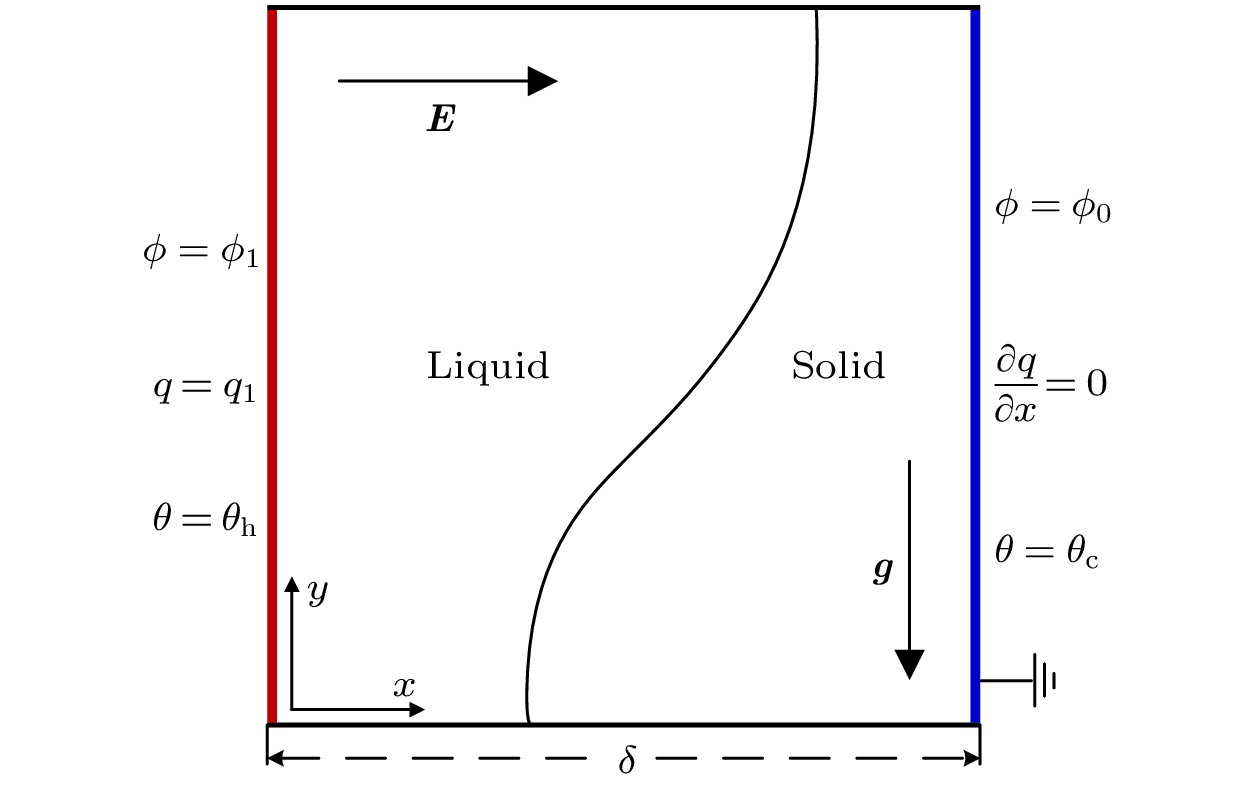
2021, 70 (14): 149101.
doi:10.7498/aps.70.20202127
Abstract +
Melting of the dielectric phase change material inside a closed square enclosure is numerically investigated. The fully coupled equations including Navier-Stokes equations, Poisson's equation, charge conservation equation and the energy equation are solved using the lattice Boltzmann method (LBM). Strong charge injection from a high temperature vertical electrode is considered and the basic characteristics of fluid flow, charge transport and heat transfer in solid-liquid phase change process under the coupling of Coulomb force and buoyancy force are systematically studied. Emphasis is put on analysing the influence of multiple non-dimensional parameters, including electric Rayleigh numberT, Stefan number
$Ste$
, mobility numberM, and Prandtl number
$Pr$
on electrohydrodynamic (EHD) solid-liquid phase change. The numerical results show that comparing with the melting process driven by buoyancy force, the applied electric field will not only change the flow structure in liquid region and the evolution of the liquid-solid interface, but also increase the heat transfer efficiency of dielectric phase change material and thus enhance the solid-liquid phase change process. In particular, we find that this phenomenon becomes more pronounced whenTis larger. Further, the dimensionless parameter
$\varPhi$
is introduced to characterize the effect of EHD enhanced solid-liquid phase change, and the results indicate that the effect of EHD enhancement solid-liquid phase change is weakened with the increase of Stefan number
$Ste$
, However the change of
$Ste$
does not make much difference in EHD enhancement solid-liquid phase change for a sufficiently high electric Rayleigh numberT, and it is attributed to the fully developed convection cells at a very early stage of the melting process. Moreover, it is found that the effect of EHD enhancement solid-liquid phase change is negatively related to the mobility numberMand that the effect of Prandtl number
$Pr$
on the EHD enhancement solid-liquid phase change largely depends on the mobility numberM, which is due to the simultaneous influence of electric field force and buoyancy force. In general, the electric field has a significant influence on the melting process of dielectric phase change material, especially at highT,
$Pr$
and low
$Ste$
,M. And quantitatively, in all tested cases, a maximum melting time saves about 86.6% at
$T=1000$
,
$Ra=10000$
,
$M=3$
,
$Pr=20$
, and
$Ste=0.1$
.
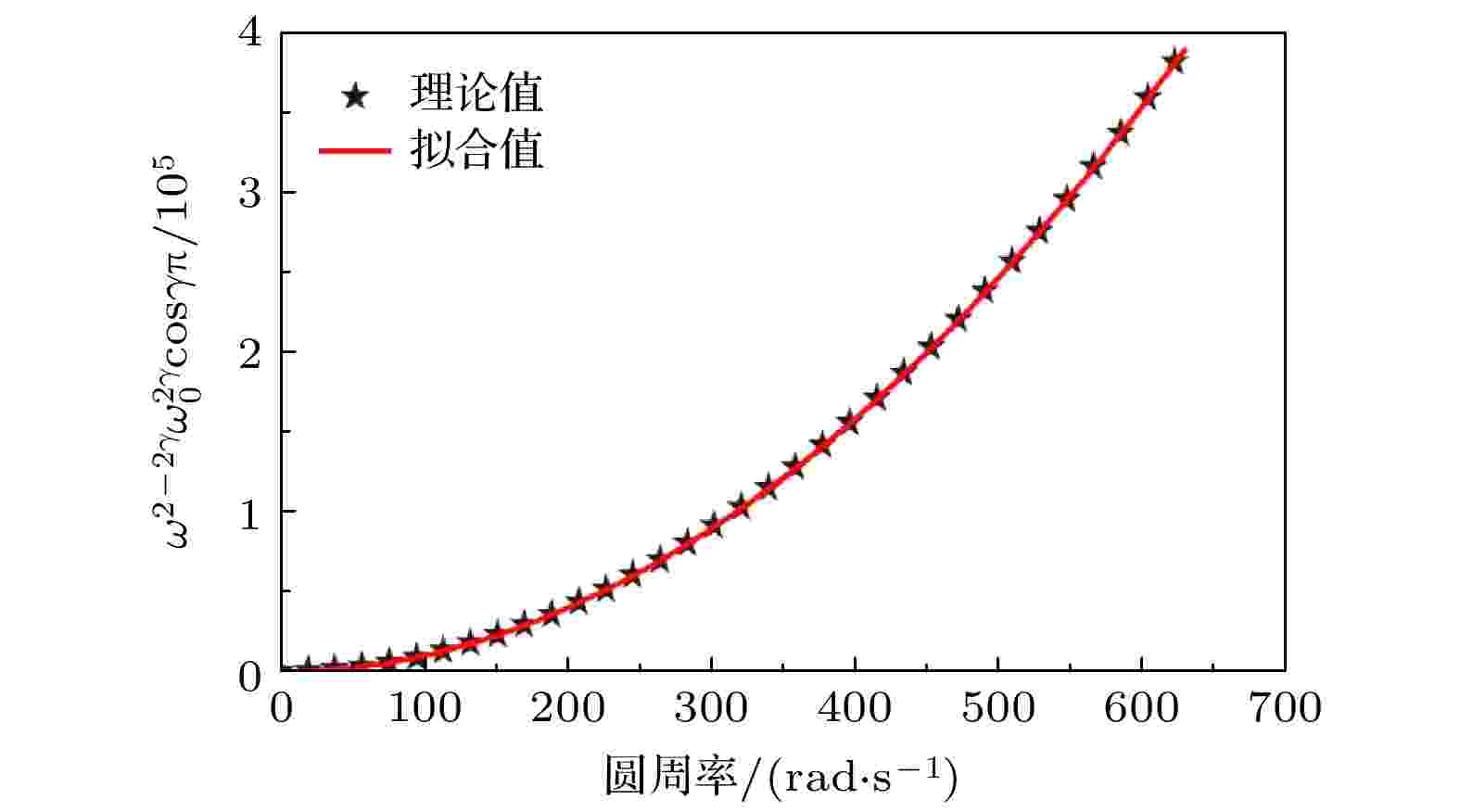
2021, 70 (14): 149102.
doi:10.7498/aps.70.20210005
Abstract +
The energy of wavefield is gradually attenuated in all real materials, which is a fundamental feature and more obvious in the media containing liquid and gas. Because the viscosity effect is not considered in the classical wave theory, the actual wavefield is different from the simulated scenario based on the assumption of complete elasticity so that the application of wavefield does not meet the expectations in engineering technology, such as geophysical exploration. In the rock physics field, the well-known constant-Qtheory gives a linear description of attenuation andQis regarded as independent of the frequency. The quality factorQis a parameter for calculating the phase difference between stress and strain of the media, which, as an index of wavefield attenuation behavior, is inversely proportional to the viscosity. Based on the constant-Qtheory, a wave equation can be directly obtained by the Fourier transform of the dispersion relation, in which there is a fractional time differential operator. Therefore, it is difficult to perform the numerical simulation due to memory for all historical wavefields. In this paper, the dispersion relation is approximated by polynomial fitting and Taylor expansion method to eliminate the fractional power of frequency which is uncomfortably treated in the time domain. And then a complex-valued wave equation is derived to characterize the propagation law of wavefield in earth media. Besides the superiority of numerical simulation, the other advantage of this wave equation is that the dispersion and dissipation effects are decoupled. Next, a feasible numerical simulation strategy is proposed. The temporal derivative is solved by the finite-difference approach, moreover, the fractional spatial derivative is calculated in the spatial frequency domain by using the pseudo-spectral method. In the process of numerical simulation, only two-time slices, instead of the full-time wavefields, need to be saved, so the demand for data memory significantly slows down compared with solving the operator of the fractional time differential. Following that, the numerical examples prove that the novel wave equation is capable and efficient for the homogeneous model. The research work contributes to the understanding of complex wavefield phenomena and provides a basis for treating the seismology problems.
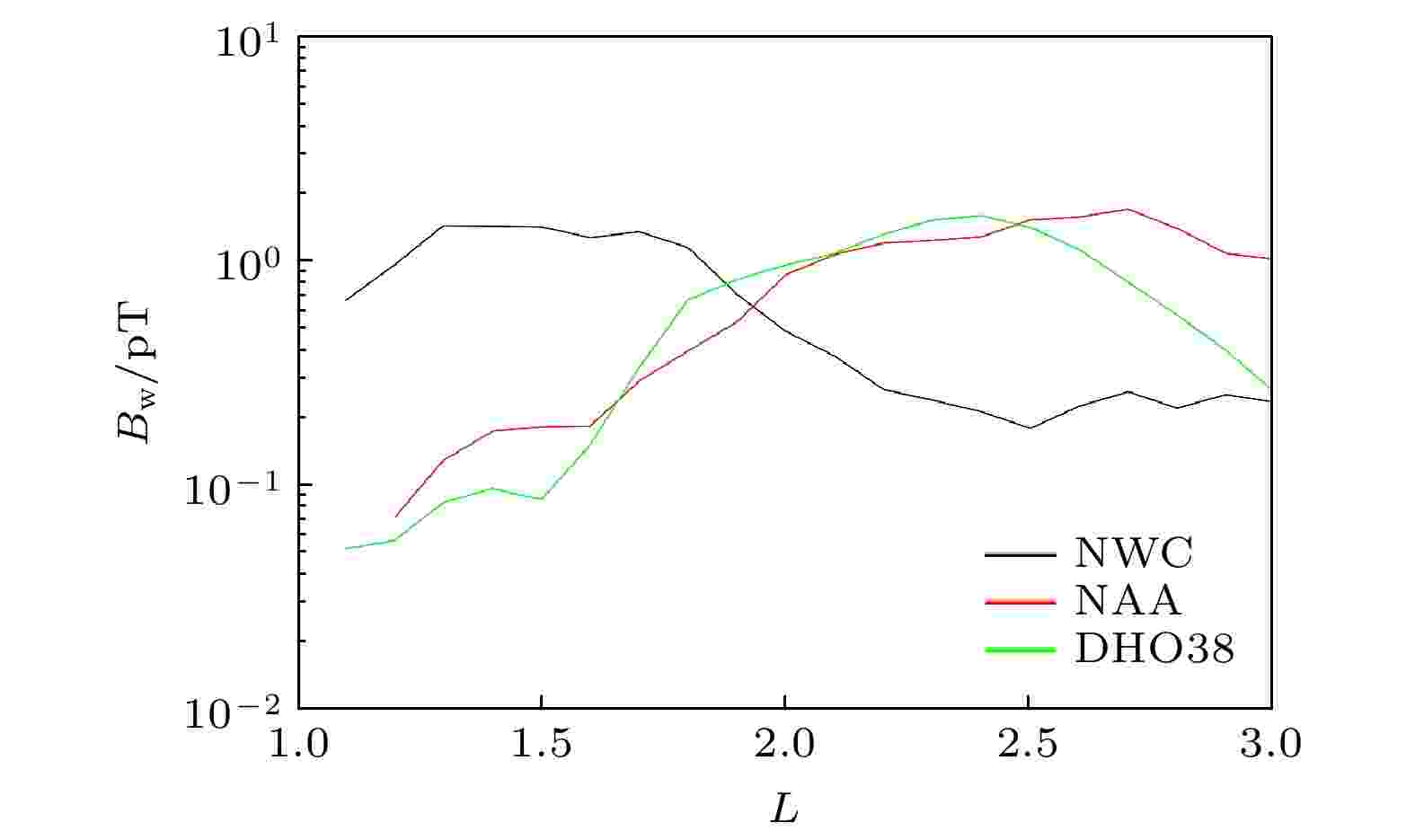
2021, 70 (14): 149401.
doi:10.7498/aps.70.20202029
Abstract +
Whistler mode very low frequency (VLF) waves from man-made ground-based transmitters in a frequency range of 10–30 kHz are mainly used for submarine communication, and they propagate primarily in the Earth-lower ionosphere waveguide and part of their energy can leak into the inner magnetosphere, leading the energetic electrons in inner radiation belt and slot region to precipitate into atmosphere and then affect the energetic electron dynamics in the near-Earth space. The scattering effects of artificial VLF signals from NWC, NAA and DHO38 transmitters on energetic electrons in Earth’s inner belt and slot region are investigated in detail in this work. Based on the quasi-linear theory and the Full Diffusion Code, we calculate the bounce-average pitch angle diffusion coefficients induced by NWC, NAA and DHO38 VLF transmitter signals, for which the resonance harmonics |N| ≤ 10 are considered, respectively. We further implement the one-dimensional Fokker-Planck diffusion simulations by using the available pitch angle diffusion rates to model the dynamic evolutions of energetic electrons caused by the scattering of the VLF transmitter signals in the inner belt and slot region in 200 d. The simulation results indicate that the NWC VLF transmitter signals are dominant in scattering ~100 keV electrons with pitch angles less than 60° atL≤ 1.8, and the mainly scattered electron energy values increase withL-shell decreasing , fromL= 1.8 toL= 1.5, the mainly scattered electron energy increases from 90–120 keV to 550–650 keV. The NAA and DHO38 VLF transmitter signals are important in scattering < 20 keV electrons with pitch angles less than 70° at higherL-shells (2.2 ≤L≤ 2.7), fromL= 2.2 toL= 2.7, the mainly scattered electron energy decreases from 10–20 keV to several keV. The VLF transmitter signals are found to have a slight influence on the loss of energetic electrons with pitch angles larger than 80°.
















